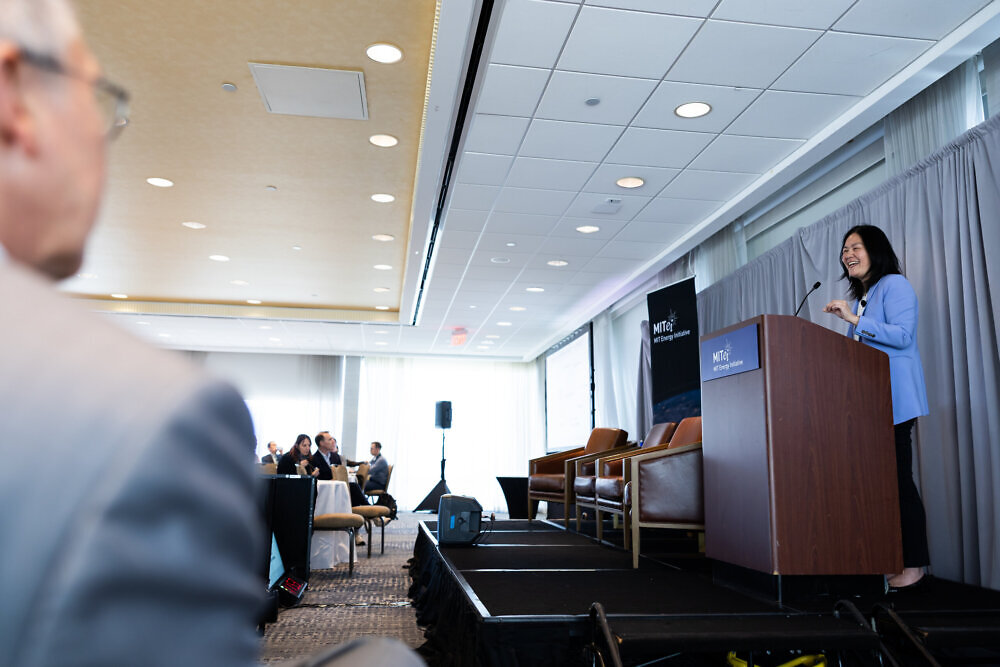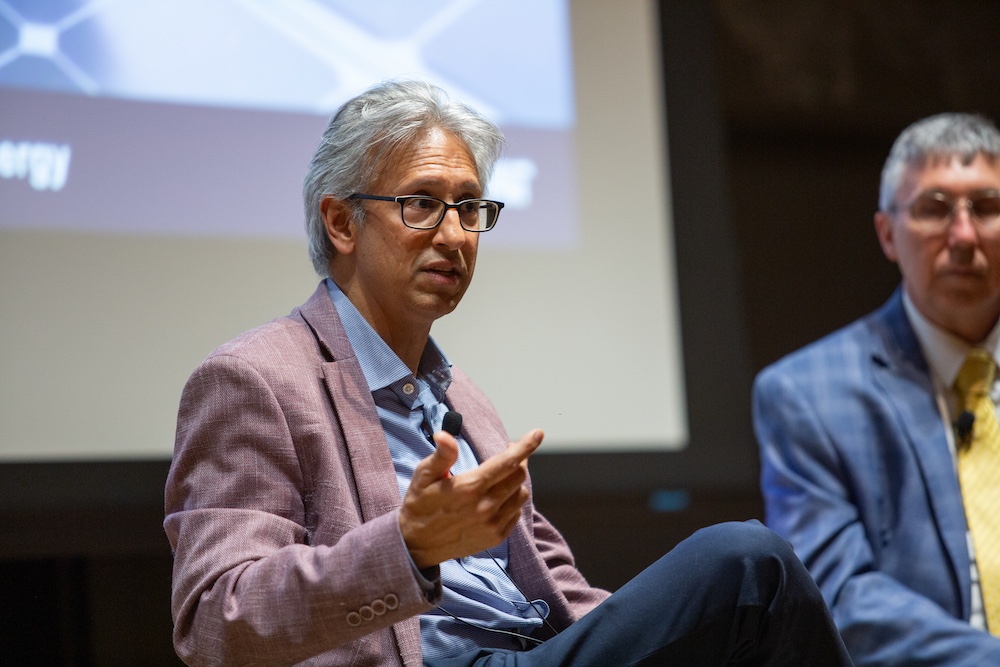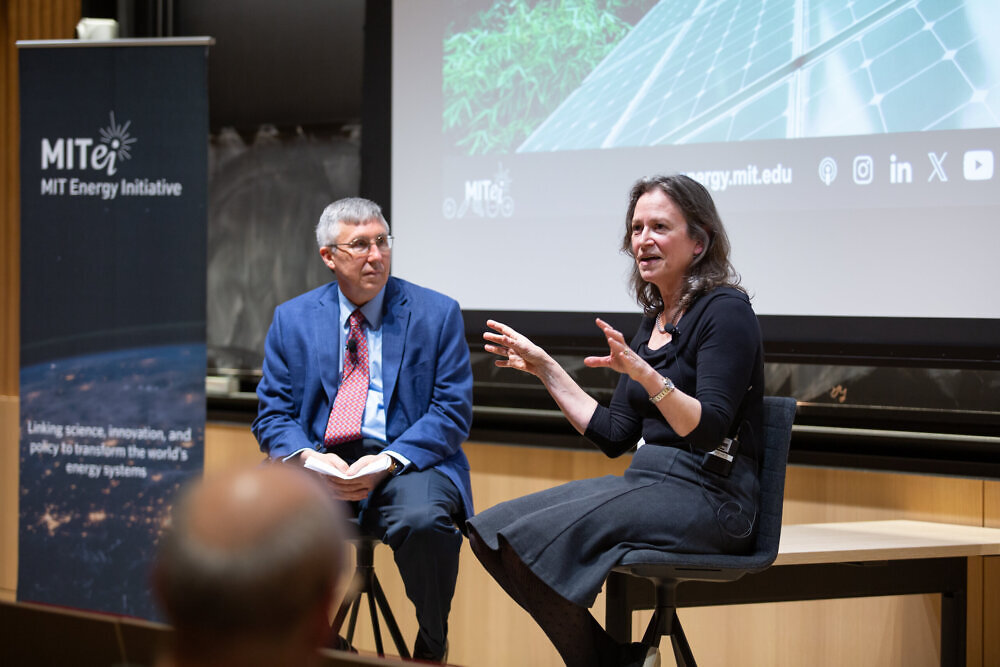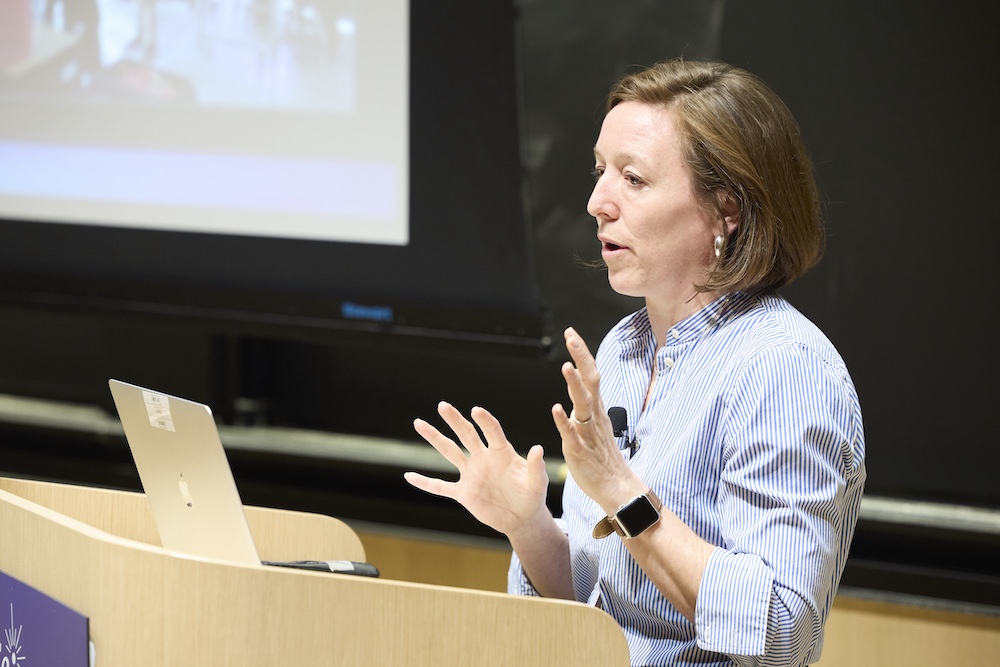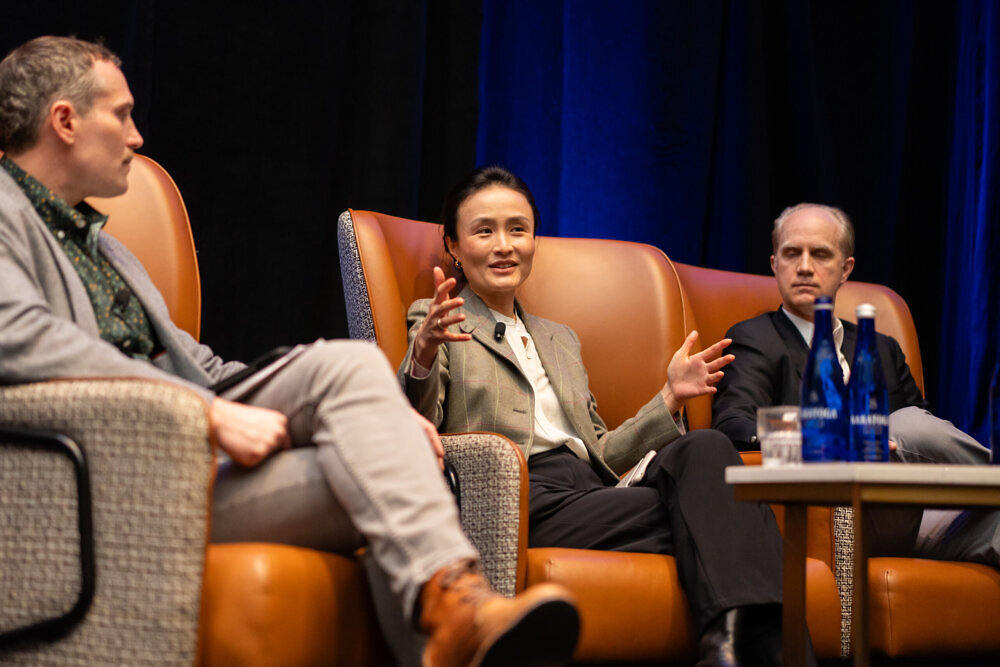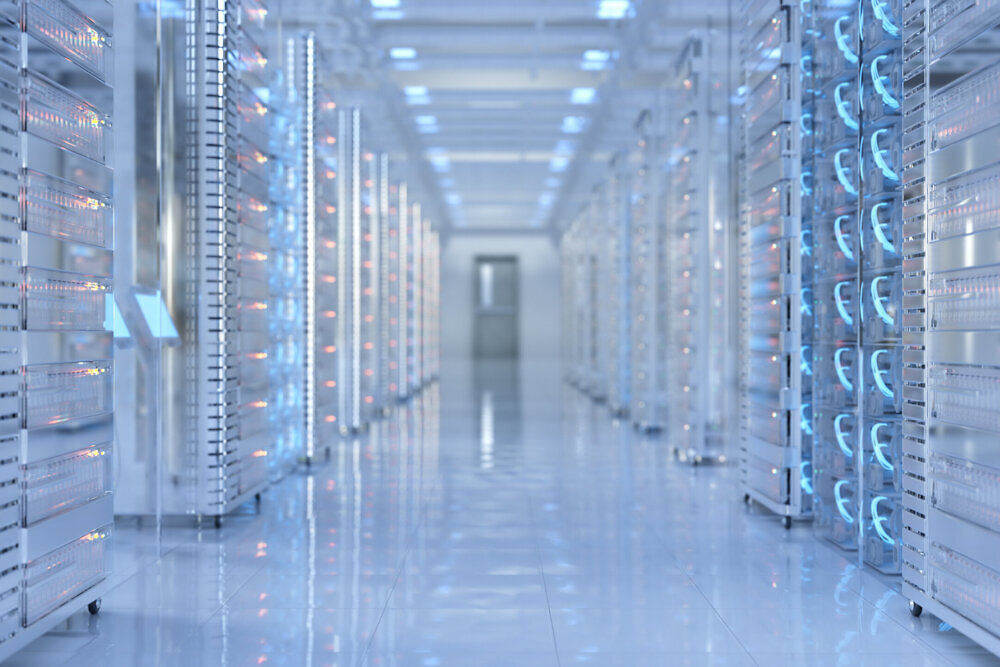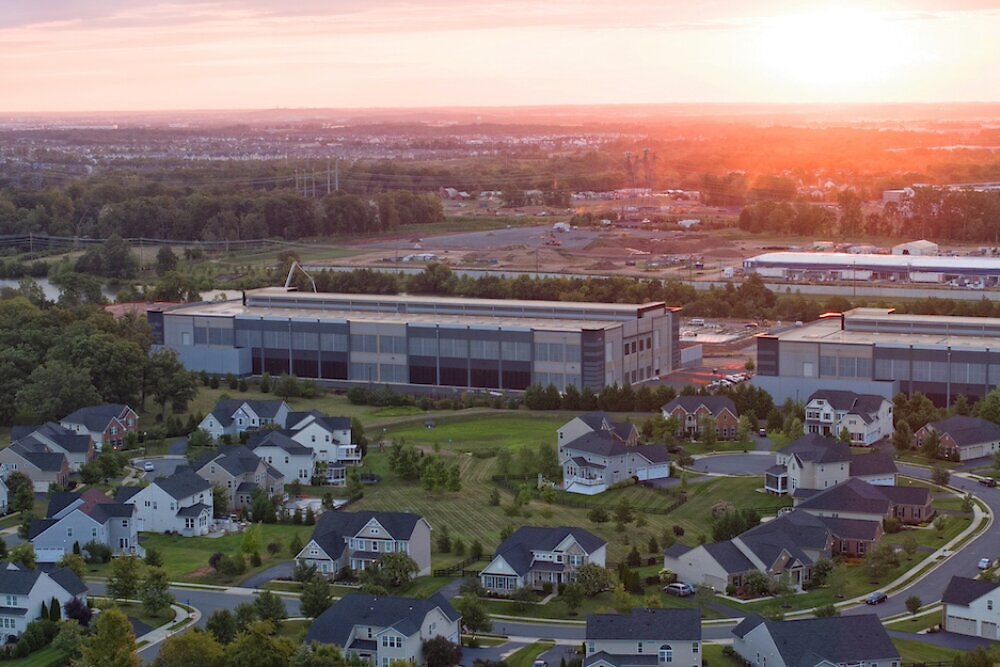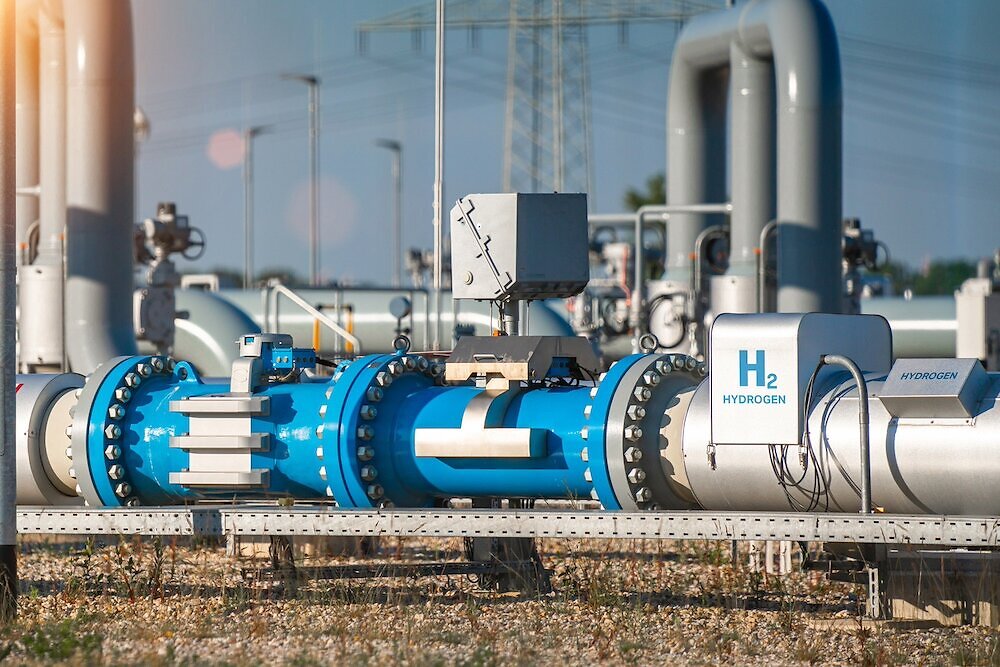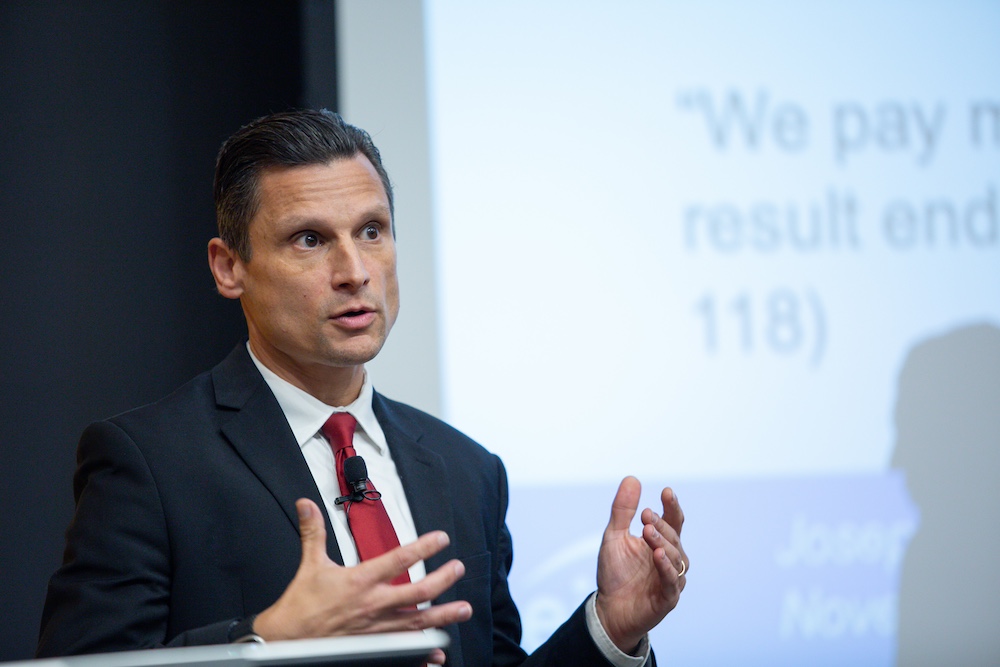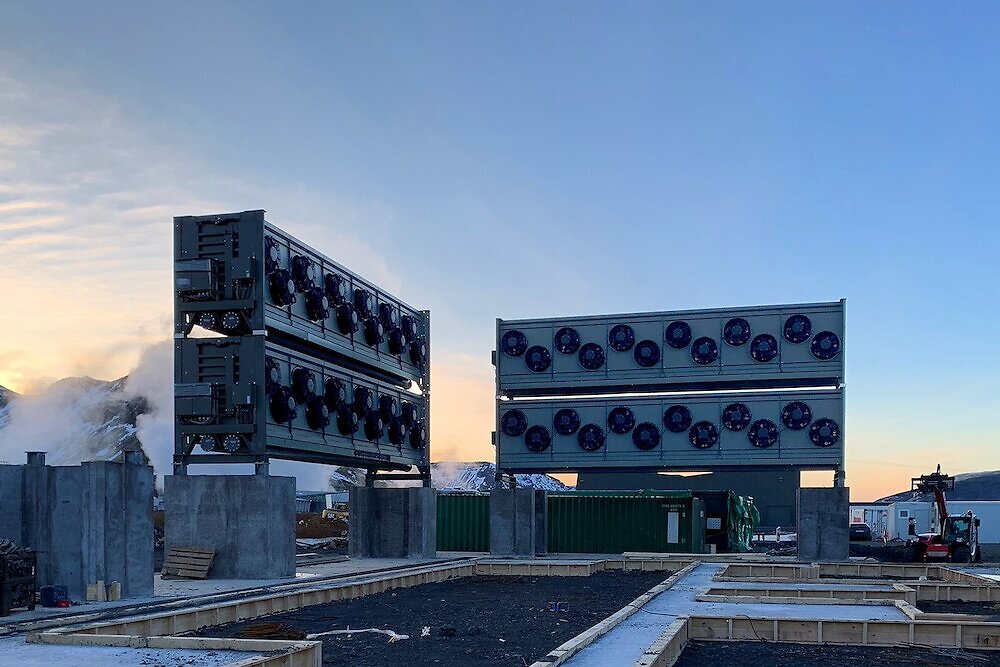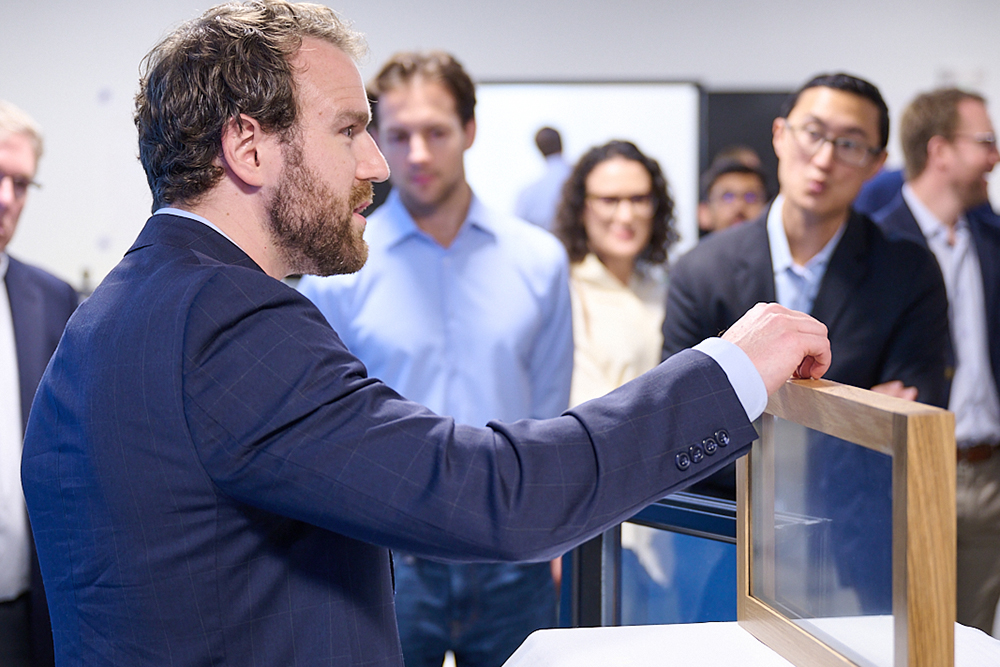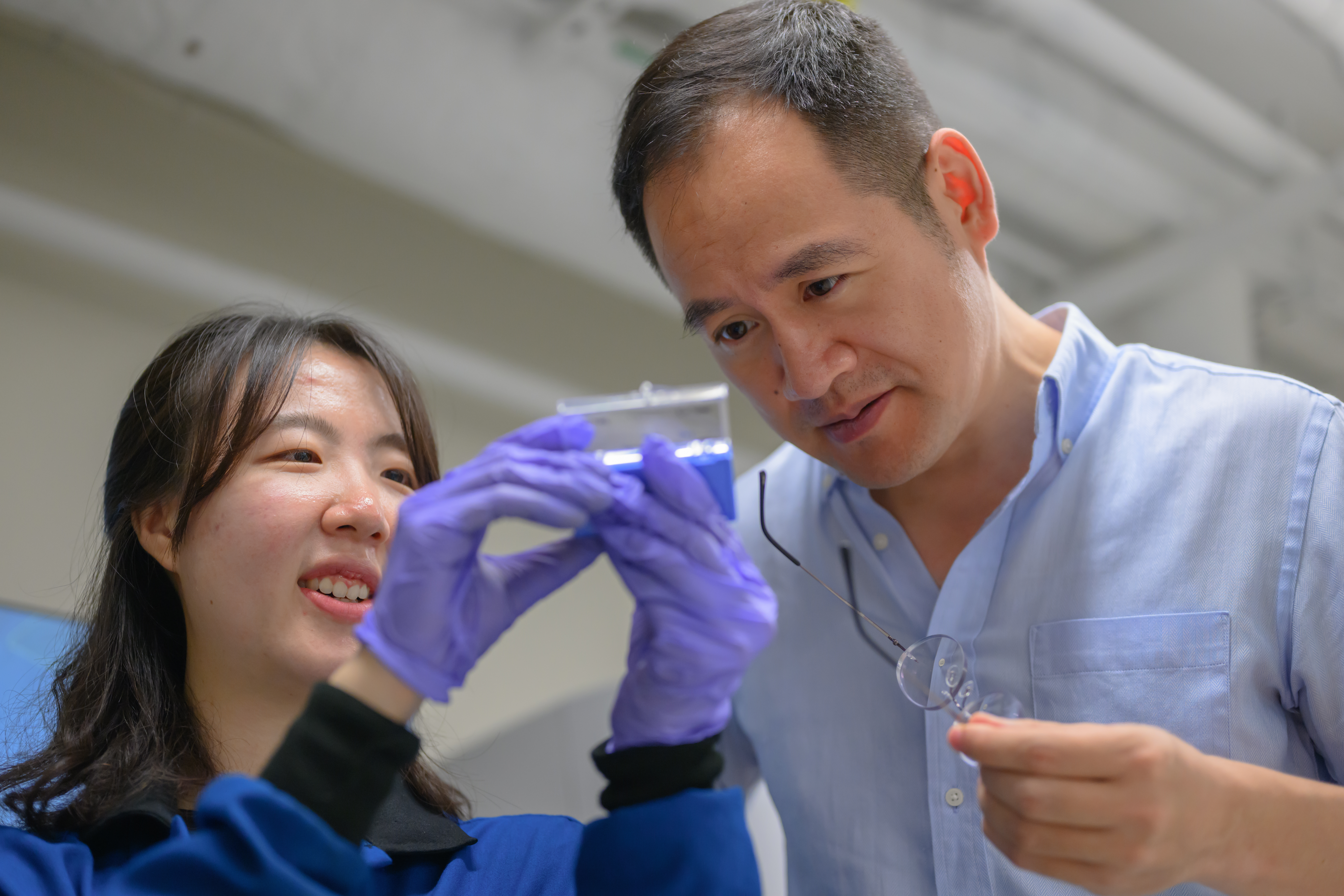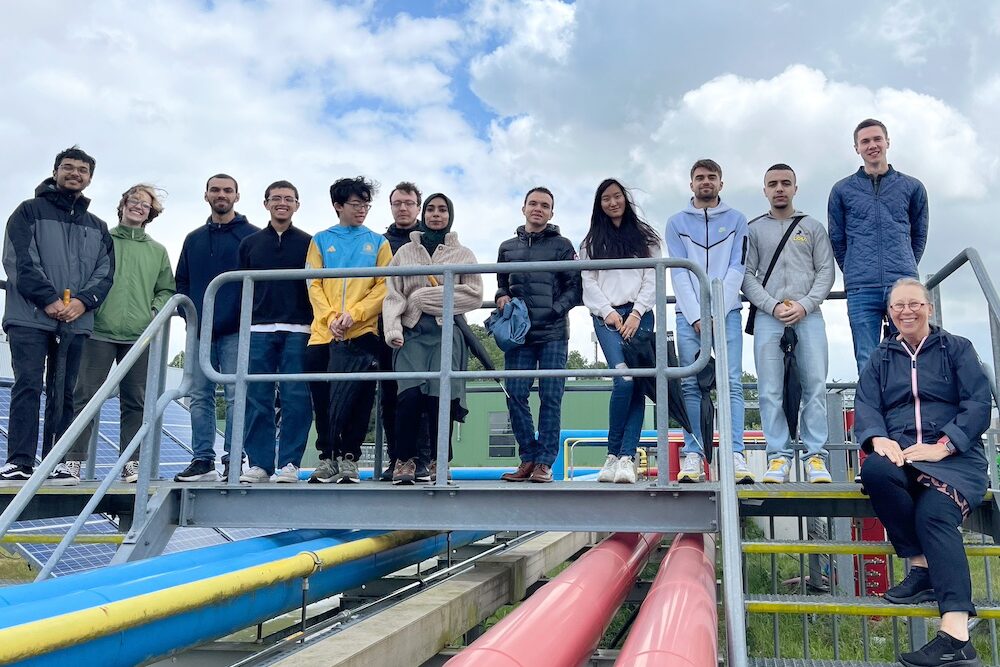
William H. Green
Letter from the Director
As I complete 18 months as director of the MIT Energy Initiative (MITEI) and look forward to MITEI’s 20th anniversary next year, I am excited about the publication of our Fiscal Year 2025 Annual Impact Report. The report demonstrates that MITEI is on solid footing, with healthy membership numbers, major new research initiatives, and increased campus engagement. MITEI remains more committed than ever to advancing low- and zero-carbon solutions for the energy transition, with the goals of increasing energy access, ensuring reliable, clean, and affordable energy, and mitigating greenhouse gas emissions.
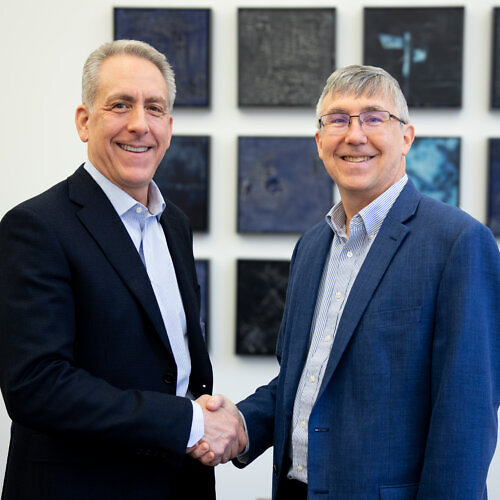
MIT Vice President for Research Ian Waitz and MITEI Director William H. Green. Photo: Kelley Travers
In our conversations over the past year, MIT Vice President for Research Ian Waitz, who oversees MITEI and MIT units like the Plasma Science and Fusion Center, MIT.nano, and the Technology Licensing Office, has reinforced the strong support MITEI has from the Institute. MIT’s senior leadership recognizes MITEI’s success in supporting energy transition research and innovation across campus, sustaining funding for graduate students and undergraduate research, convening important energy events, and producing highly respected and rigorous reports on emerging energy technologies.
MITEI completed Fiscal Year 2025 (FY25) with a fully staffed leadership team. Carolyn Ruppel (SB, SM ’86, PhD ’92), who has had a long research career in energy and climate, most recently at the U.S. Geological Survey and earlier on the faculty at Georgia Tech, joined MITEI in March as the deputy director of science and technology. We were also fortunate to recruit Morgan Andreae (PhD ’06), formerly executive director for technology and innovation at Cummins, to become executive director of MITEI’s Future Energy Systems Center consortium.
Shifting priorities for external energy funding have posed challenges for MIT researchers this year, but MITEI’s industry-sponsored model has proved resilient. MITEI had 38 member companies in FY25, and our roster of already-renewed Founding and Sustaining memberships will ensure stable sponsored funding for MIT’s energy transition research for the next few years. MITEI is working with several current and prospective member companies that have expressed interest in enhanced energy research portfolios at MIT. MITEI member agreements are increasingly enabling companies to engage more broadly with MIT through involvement in other research consortia or a wider range of sponsored research topics.
At the close of FY25, MITEI prepared several initiatives for imminent launch. The Data Center Power Forum offers our members access to the combined expertise of MITEI and Sloan School’s Center for Energy and Environmental Policy Research (CEEPR) on topics such as data center energy supply and storage, grid design and management, infrastructure, and regulatory and economic policy. The Forum builds on ~20 already-funded MITEI projects in these areas and complements MIT’s expertise in quantum computing, low-energy electronics, photonics, efficient algorithms, and the societal consequences of data center expansion. In early 2026 MITEI will launch a two-year study on the Future of Fuels for aviation and long-distance rail, shipping, and trucking, with myself as the study director, MITEI’s Director of Research Randall Field as executive director, and experts from across MIT as contributors. The study, whose advisory board is open to both MITEI members and non-members, will evaluate drop-in fuels and e-fuels side-by-side with other fuels and consider regional differences in feedstock availability, markets, and regulatory frameworks.
In addition, the Future Energy Systems Center has established for its members a focused interest group and advisory board on long-duration energy storage, forging a new research model that will be adaptable to other high-priority energy topics. The topic of long-duration energy storage has proved to be of interest to MITEI members from a variety of sectors, including energy, power, heavy industry, and infrastructure. MITEI has also initiated an effort called CLEAR (Consistent Lifecycle and Economic Assessment Recommendations) that both MITEI member companies and others may support. CLEAR is co-led by myself and Professor Elsa Olivetti (DMSE and the Climate Project) and involves an international group of experts as a steering committee. CLEAR teams are establishing best practices for techno-economic analyses and lifecycle assessments of energy technologies and formulating educational materials to train the next generation of energy analysts for industry and academia.
MITEI continues to have an outsized impact at MIT and beyond. In April, MITEI partnered with MIT Sloan School’s Climate Policy Center and the MIT Washington Office to co-host the multi-day Senior Congressional Staff Seminar, which was attended by a bipartisan group of 27 staffers. The FY25 MITEI Presents: Advancing the Energy Transition seminars hosted such luminaries as the leader of the U.S. Energy Information Administration and the presidents and CEOs of the Natural Resources Defense Council and of the Engine, MIT’s nonprofit incubator and tough-tech accelerator. MITEI’s 2025 Spring Symposium, “AI and energy: Peril and promise,” explored how AI is accelerating the energy transition while also dramatically increasing energy demand. And MITEI’s newly launched energy transition podcast, “What if it works?” attained more than 1,000 subscribers in its first year.
MITEI’s education programs extend our reach across MIT and to the global community. To support undergraduate energy education and training, MITEI manages the integrative Energy Studies Minor, sponsors faculty to develop new energy courses, and funds teaching assistants and IAP short courses. Since its inception, MITEI has sponsored more 1,000 energy UROP projects, including 85 in FY25. About 1,700 graduate students have been supported on MITEI projects since 2006, with more than 540 named as Energy Scholars. Energy Scholar alumni serve in technical and executive positions at established companies as well as MIT energy startups. Some of the most successful of these startups were in turn spawned by inventions originating as MITEI seed grants. Through our online open learning courses, MITEI’s energy expertise reaches the world, with over 26,700 students enrolled in FY25.
As we commence planning for MITEI’s 20th anniversary, MITEI is honored to be recognized for its key role in sustaining energy transition research and education at MIT. We are proud of the achievements described in this FY25 impact report and look forward to continuing to support the MIT energy community through grants from the Future Energy Systems Center and seed funds, sponsored research, the Energy Scholar and UROP programs, and other initiatives.
Sincerely,

William H. Green
Director, MIT Energy Initiative
Hoyt C. Hottel Professor of Chemical Engineering
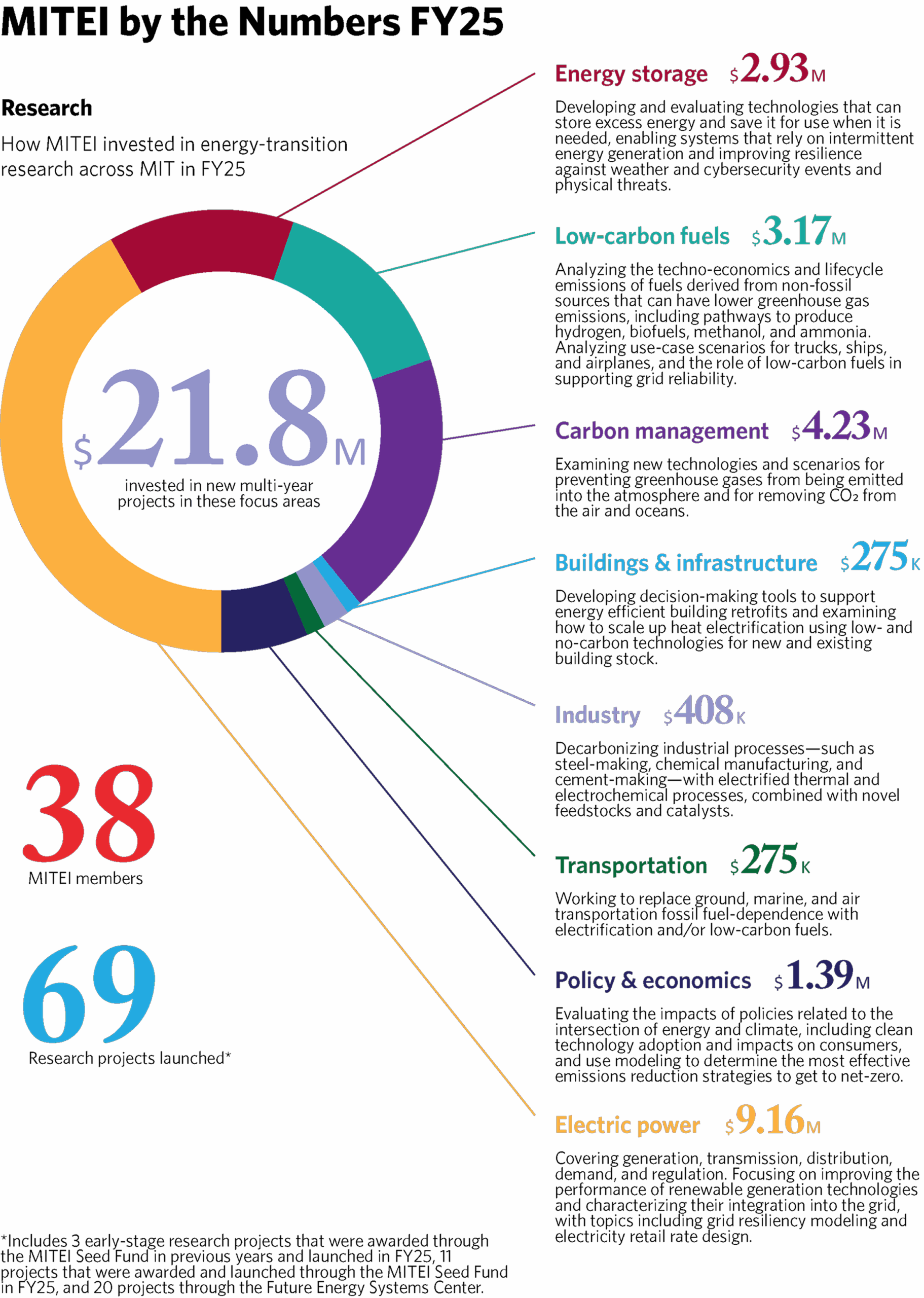


Overview and Mission
The MIT Energy Initiative (MITEI), MIT’s hub for energy research, education, and outreach, is advancing zero- and low-carbon solutions to expand energy access and combat climate change. MITEI is a crucial rallying point for MIT researchers and educators who share our vision and commitment to dramatically reduce emissions through the development of novel technologies and delivery of science-based analysis. Together we are dedicated to decarbonizing global energy systems and building upon MIT’s long tradition of working collaboratively and transparently with industry, government, and civil society.
William H. Green, the Hoyt C. Hottel Professor at MIT, was named as MITEI’s fourth director in April 2024, making FY25 his first full year in that role. Carolyn Ruppel (SB, SM ’86, PhD ’92), who had a long research career in energy and climate, most recently at the U.S. Geological Survey, joined MITEI as deputy director of science and technology in March 2025.
With a significant change in leadership—along with the naming of a new director and new deputy director, eight of the 11 leadership team members were new to MITEI or new in their current roles within the last three years—MITEI identified five key priorities in FY25:
- Encourage and help MITEI’s sponsors to fund more energy research with MIT faculty
- Address the challenge of data centers’ energy demand
- Organize the engineering community to do better assessments of new energy technologies
- Make a plan to revitalize energy education at MIT
- Engage more broadly with campus
This report provides more detail about progress on each of these priorities.
Research & Analysis
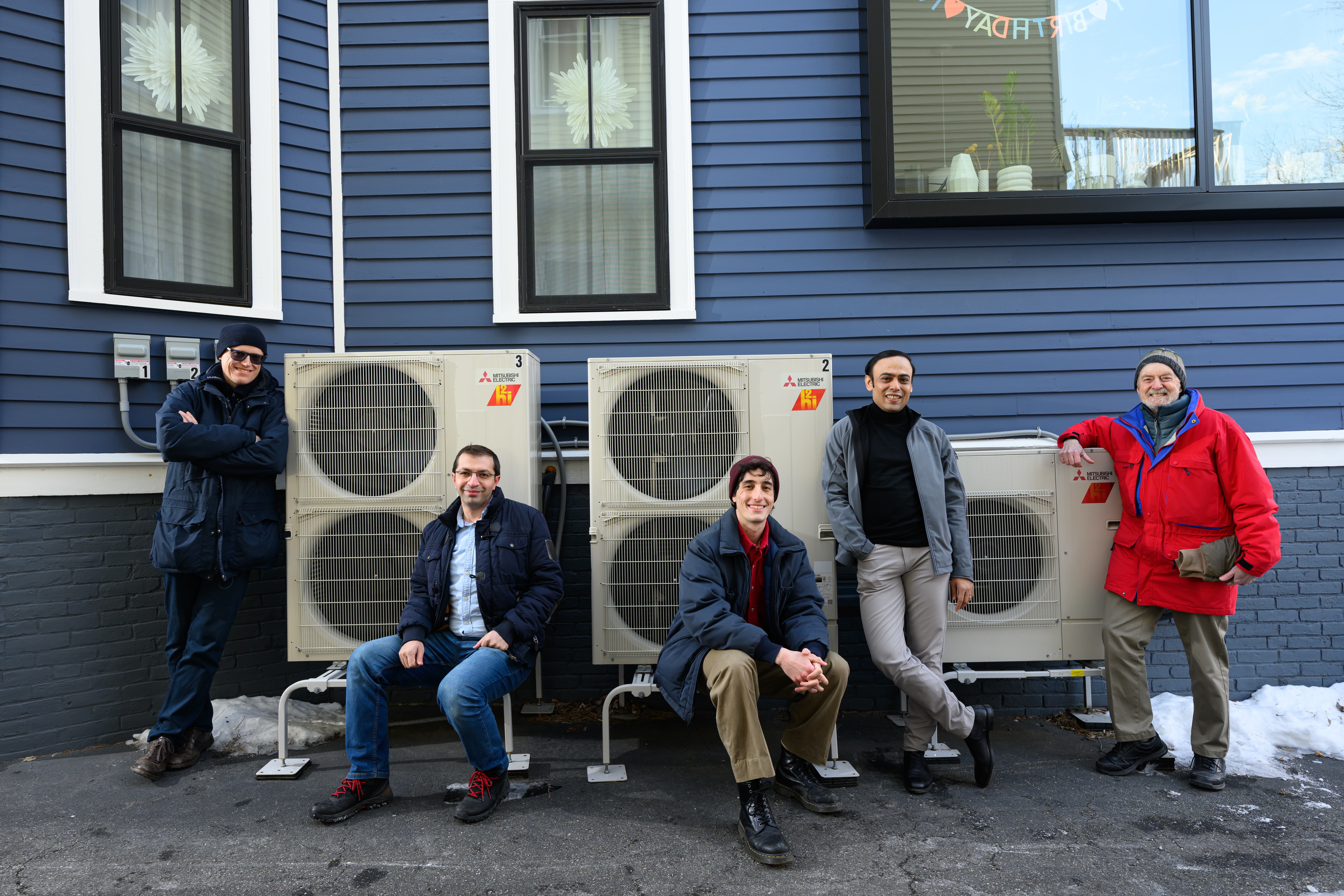
A modeling study by an MIT team has shown that electrifying residential heating can be a substantial step toward reducing carbon emissions as well as costs over the combined electricity and natural gas sectors. Photo: Gretchen Ertl
Priority update: Encourage and help MITEI’s members to fund more energy research with MIT faculty
In FY25, MITEI raised more than $30 million in multi-year commitments from new and renewing members. This funding supports MIT researchers in advancing MITEI’s mission of accelerating the energy transitionand also sponsors research by undergraduate and graduate students and postdocs. Our Member Relations team actively seeks to grow research funding by bringing in new members, and by working closely with existing members to conceive and execute new research projects MITEI has a regular process of engagement with its corporate members. Through facilitated meetings with faculty, scheduled events covering many technologies, and customized workshops involving teams of MIT principal investigators (PIs), MITEI discovers topics of interest to its members and identifies opportunities for substantive collaborations with MIT researchers. Research takes the form of both sponsored projects by individual companies and jointly sponsored activities in areas of mutual member interest. Leveraging MITEI’s existing administrative infrastructure, we are able to quickly initiate new projects with researchers across the MIT campus when we find a match between capabilities and member interest. Where we identify new strategic areas of focus, we build the collaborative foundation for future work in critical areas such as data center power, low-carbon fuels, and long-duration energy storage.
Priority update: Address the data center problem
In 2023, data centers consumed about 4.4% of the total electricity supply in the United States. With the burgeoning number of data centers, the demand for energy is projected to far exceed the power supply in the future. The growing energy demand from data centers was one challenge MITEI recognized when we identified the theme for our 2024 Annual Research Conference as, “A durable energy transition: How to stay on track in the face of increasing demand and unpredictable obstacles.” A panel discussion with key stakeholders examined this topic more deeply at the MITEI fall conference. The 2025 Spring Symposium, “AI and energy: Peril and promise,” continued that exploration by looking at the key challenges and opportunities at the nexus of AI and energy. For broader audiences and to help inform the public on this urgent issue, we also published an article highlighting the data center/energy challenge and a brief video featuring MITEI Director William H. Green explaining the issues we currently face.
In FY25, MITEI began exploring the launch of a members’ interest group focused on the urgent energy needs arising from the rapidly growing demand for electricity for data centers. The Data Center Power Forum , launched in early FY26, is leveraging MITEI’s established expertise and leadership in convening multiple energy sectors to consider a timely and complex issue facing many companies.
Priority update: Organize better assessments of newenergy technologies
The true potential of new technologies to address energy and climate challenges is too often obscured by inconsistent approaches, assumptions, or valuations within techno-economic analyses and lifecycle assessments. This failure erodes trust and undermines promising technologies in the eyes of investors, policy makers, and the public. In collaboration with the MIT Climate Project, MITEI is committed to defining best practices and standards for assessing the technical and economic viability and evaluating the climate benefits of new energy technologies. This is critical to empowering stakeholders to make clear, data-backed decisions about the new technologies meriting support. We have recruited renowned researchers in techno-economic and emissions assessment to serve on a steering committee. The first meeting was held in early June 2025. Under the leadership of MITEI Director William H. Green, and Elsa Olivetti, the Jerry McAfee Professor in Engineering, the goal of the Consistent Lifecycle and Economic Assessment Recommendations (CLEAR) effort is to develop state-of-the-art assessment approaches that can produce reliable, robust results grounded in trusted principles and data.
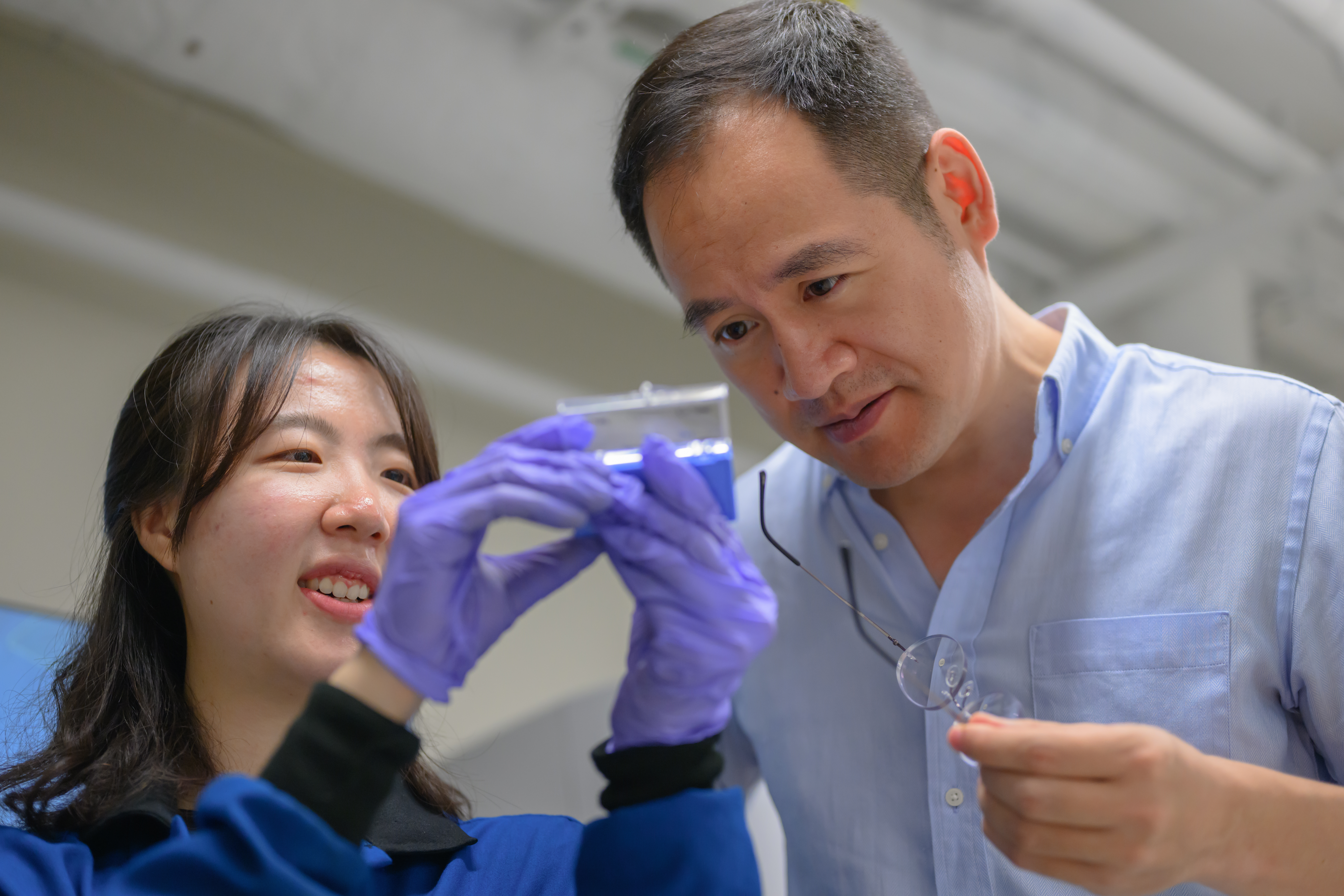
MIT engineers have demonstrated that adding nanoparticles of certain ceramics to the metals inside fusion reactors can protect them from damage and significantly extend their lifetime. Above: Professor Ju Li (right) and postdoc So Yeon Kim examine samples of the composite they have fabricated for their demonstrations. Photo: Gretchen Ertl

MIT PhD candidate Shaylin A. Cetegen (above) and her colleagues, Professor Emeritus Truls Gundersen of the Norwegian University of Science and Technology and Professor Emeritus Paul I. Barton of MIT, have developed a comprehensive assessment of the potential role of liquid air energy storage for large-scale, long-duration storage on electric power grids of the future. Photo: Gretchen Ertl
Research Highlights
In July 2024, Randall Field was named director of research to guide MITEI’s energy systems research and strengthen collaboration with other MIT research teams. Field is the former director of MITEI’s research consortium, the Future Energy Systems Center, and was one of the first employees of MITEI at its inception in 2006. In August 2024, Morgan Andreae (PhD ’06) was named as the new executive director of MITEI’s Future Energy Systems Center. MITEI’s research portfolio reflects our primary objective of decarbonizing the global economy with low-carbon technologies and through integrated energy systems supported by effective policy. Our work is guided by the use of advanced system modeling and analysis techniques to assess the feasibility of decarbonization technologies and pathways, against the backdrop of the energy system as a whole, from an economic and technical standpoint. MITEI also assesses the total lifecycle emissions of these technologies. MITEI’s three in-house research scientists have deep expertise in techno-economic analysis and lifecycle assessments for energy transition technologies and approaches. They frequently bring this expertise to joint projects conducted with researchers in MIT’s engineering and science departments, particularly in the areas of grid design and management, data center power, low-carbon energy sources, and sustainable transportation.
With both member and philanthropic funding, MITEI launched 69 research projects in FY25 totaling about $22 million. The focus area of new projects in FY25 that garnered the most research support was electric power, which includes both grid management and design and power generation, with funding of $9.16 million. The balance of FY25’s research funding was allocated to support a range of other energy topics, including carbon management, low-carbon fuels, and energy storage. With support from its members, as well as numerous foundations, donors, various state and federal government entities, and university partners, MITEI has supported 1,078 projects from its inception through FY25.
Funding for early-stage research
In FY25, seven early-stage research projects submitted during the annual MITEI Seed Fund call were funded for a total of more than $1.2 million. Over the last four cycles, just over 30% of the projects receiving MITEI seed funding have been related to batteries or storage, demonstrating the importance of innovation in energy storage if renewable energy is to reach its full potential in helping to decarbonize the energy system. Through FY25, MITEI has supported more than 226 energy-focused seed projects with grants totaling $29.8 million.
The Future Energy Systems Center
In August 2024, Morgan Andreae (PhD ’06) was named executive director of MITEI’s Future Energy Systems Center, MITEI’s member-funded research consortium and a vital component of MITEI’s research program. The Center funded 20 new projects in FY25, with topics ranging from the hurdles facing small modular nuclear reactors in industrial settings to the interplay between hydrogen production and renewable fuel synthesis. The Center’s research portfolio aims to foster and inform interdisciplinary energy research across MIT, accelerating progress toward a net-zero carbon future. Using techno-economic and lifecycle analysis to examine energy pathways in different sectors, the Center enables its corporate members to explore and develop strategic energy plans, taking into consideration technology, economics, and policy.
- Future Energy Systems Center projects: The 20 new Future Energy Systems Center projects funded in FY25 bring the number of system modeling and analysis projects underway or completed within the Center to 53. MITEI kicked off meetings for the 10 newest projects at the Center’s September 2025 Workshop. Our latest call for project proposals was sent to MIT’s 1,300 PIs in July 2025, and a new cohort of projects is being selected in the fall.
- Future Energy Systems Center meetings and workshops: In May, the Future Energy Systems Center held its spring workshop to address timely energy topics of interest to our members. Topics included deep geothermal, an improved business case for new fission power plants, and how policy reversals shape the U.S. and international energy landscape. The Center also held its advisory committee meeting and hosted student presentations and a poster session.
- Future Energy Systems Center webinars: The Center hosted 17 webinars in FY25, as well as four lightning talk sessions. The webinar series is a platform for MIT researchers from across departments to share insights on emerging technologies, policy developments, and sustainability challenges by highlighting the latest updates from their Center-supported projects.
There are 36 Future Energy Systems Center members. The member companies span four continents and are involved in many industries, including energy, utilities, automotive, semiconductors, mining/metals, chemicals, telecommunications, infrastructure, insurance, and engineering/construction. MITEI is also in discussion with a number of prospective members.
Studies and reports
The role of fusion energy in a decarbonized electricity system, published in September 2024, showed that fusion energy could be a major contributor in future electric power systems and identified what is required to achieve that potential. The report was based on a one-and-a-half-year study examining the factors likely to shape the deployment and utilization of fusion energy. This study applied a multi-disciplinary approach using techno-economic analysis and modeling to investigate the factors, such as cost and climate policy, that will impact the deployment of fusion power plants. Several key findings emerged from this study:
- Fusion has a potential societal value in the trillions of dollars in a decarbonized world.
- The scale of fusion deployment in the electricity system will depend on fusion power plant costs.
- The scale and timing of fusion deployment in different regions of the world will be driven by economic growth, population density, electrification needs, regional costs, decarbonization targets, relative prices of electricity, limitations of fission-based nuclear generation, and resource availability for other low-carbon technologies (wind, solar, and biomass).
- The scale of fusion deployment in the electricity system will highly depend on the availability and cost of other low-carbon technologies and on how tightly carbon emissions are constrained in the future.
- Key cost drivers for fusion power plants include reactor equipment cost, regulatory considerations, and operations and maintenance costs.
Projects
MITEI-supported research in FY25 advancing the science, technologies, and policies needed to reach net-zero carbon emissions by 2050 and expand energy access.
AI-driven building flexibility through virtual power plant (VPP) operation
AI optimization algorithms for buildings operating as virtual power plants: enhancing efficiency and sustainability.
[MITEI Seed] Solution-processable microporous semiconductors for electric-field enhanced CO2 capture: a novel approach
This project focuses on adding electrical conductivity to microporous polymers, which can provide a new mechanism for industrial processes, such as membrane-based separations, adsorption, and catalysis.
[MITEI Seed] Low temperature route for catalytic ammonia decomposition via a novel method of inputting energy where it counts
This project aims to explore the underlying basic science of an energy efficient process to decompose ammonia into hydrogen and nitrogen gas. The development of a low temperature ammonia decomposition reactor would revolutionize utilization of ammonia as a hydrogen carrier, thereby facilitating the use of clean, sustainable hydrogen as a fuel.
[MITEI Seed] Digital twins for efficient and reliable EV battery management: adaptive fast charging and fault prognostics
Addressing cell-to-cell variability in battery packs is a key challenge for ensuring efficient and reliable electric vehicle (EV) operation. This project aims to develop digital twins (DTs) that accurately capture the inherent and evolving variability of cells within battery packs during EV operations. These DTs will enable an adaptive approach to optimize fast charging protocols… Read more
[MITEI Seed] Robot learning from human operators for efficient renewable energy infrastructure maintenance
This research will develop robots that can learn maintenance tasks from natural human feedback, including physical intervention and verbal instructions. A key innovation is enabling a fleet of robots to intelligently coordinate when to ask for human help, allowing one operator to efficiently supervise multiple robots performing renewable energy infrastructure maintenance. By leveraging human-in-the-loop robot… Read more
[MITEI Seed] Electrochemical redox-mediated separation and recycling of rare earth elements
Rare earth elements (REEs) are crucial components in high-tech products, particularly in green technologies such as electric vehicles and wind turbines. However, because of their physical and chemical similarities, REEs are very challenging to separate. Due to this, current REE processing techniques require multiple stages and are chemically and energy-intensive, dampening the realized environmental benefits… Read more
[MITEI Seed] Sustainable energy transition pathways for Africa
By bringing together and enhancing existing MIT modeling tools, this project will enable a holistic assessment of the economic, environmental and social implications of a range of plausible decarbonization and energy transition scenarios for African sub-regions, illuminating potential tradeoffs across different dimensions of sustainability. As such, this work will be able to provide important missing… Read more
[MITEI Seed] Accelerating energy planning in the era of data-centers through generative AI
This project develops DecarbAI, an AI-powered tool to modernize electric grid planning amid rising energy demand from data centers. By using large language models and machine learning to interpret regulations, climate data, and infrastructure maps, it enables faster, more adaptive planning. DecarbAI targets key bottlenecks like permitting delays and interconnection studies, helping planners align clean… Read more
Incorporating weather information into power resource accreditation and capacity mechanisms in wholesale electricity markets
Evaluation of weather impacts on power resource accreditation and incentivizing resource investment through capacity mechanisms.
Watts vs bytes: energy storage impact analysis on flexible computing loads
Analyze impact of joint optimization of energy storage and delay-tolerant computing loads for reducing carbon and energy cost, while maintaining computing quality of service.
Characterizing the trade-off between CO2 capture rate and energy efficiency in amine-based carbon capture under variable feed conditions
Assess the trade-off between the average carbon capture rate and capital/energy efficiency for reactive amine-based carbon capture plants.
Solar-to-liquid fuel efficiency of photoelectrochemical and photochemical CO2 reduction higher than 2%
This project explores how to convert sunlight and CO₂ into liquid fuels using two different methods. We aim to reach over 2% efficiency, a key step toward practical use. The goal is to create cleaner fuels that reduce fossil fuel use and carbon emissions. If successful, this approach could offer a low-cost way to make… Read more
Evaluating the impact of data center deployments on the U.S. power system
Evaluation of system-level impacts of data centers on the power sector with a focus on optimizing location and demand response strategies and its policy implications.
Renewable energy siting for low-cost and extreme event-resilient power systems under climate change
Develop best practices for renewable siting across real-world decarbonization pathways in diverse climate/geographic regions with minimized risk. Reveal geophysical and regional power grid drivers of system design, with a focus on system-level cost and resilience to extremes. Synergy and impact on risk-aware decision-making for data centers.
Development and validation of AI models for disruption prevention on SPARC-Part II
The projects seeks to use AI tools to better model and predict plasma behavior – and in particular to predict disruptions – which is necessary in order to achieve practical fusion power generation.
Scientific monitoring and modeling of mCDR operations
Marine carbon removal technologies could help address rising atmospheric CO₂ levels, but fundamental scientific gaps in ocean carbon monitoring and modeling limit our ability to verify their climate benefits. This project tackles core scientific questions underpinning measurement, reporting, and verification through rigorous research at active technology trials, developing the scientific foundations necessary for cost-effective, operationally… Read more
Sensitive, radiation-resistant, cost effective and scalable neutron scintillators
The project seeks to develop cost effective neutron detectors, which are critical for fusion power generators, and other applications like radiation monitoring and medical imaging.
Carbon dioxide removal (CDR) supply curve project
One method to mitigate climate change is to remove carbon dioxide that has already been released to the atmosphere. There are many possible methods for carbon dioxide removal (CDR). Some of these are nature-based solutions, such as reforestation. Others are engineered solutions, such as direct air capture (DAC). These methods have different costs and energy… Read more
[MITEI Seed] Advancing flame-assisted spray pyrolysis (FASP) methods for low-carbon fast-synthesis of cathode materials for Li-ion batteries – phase 2
Decarbonizing cathode materials will directly reduce the emissions from EV manufacturing. Moreover, as carbon emissions are closely associated with high energy consumption, developing technologies that lower energy usage is the key to controlling carbon emissions. As a result, our efforts could potentially lead to a new manufacturing route featuring low energy consumption, low emissions, and… Read more
Options for scope 2 emissions accounting – own emissions, offsets and impact accounting
This project addresses corporate accounting for Scope 2 GHG emissions, which are attributable to purchased electricity and other energy. The objective is to define accounting rules which provide more information. Defining emissions for electricity purchased from the grid can be difficult since the grid is a pool of electricity produced by a variety of generators.
End use of agricultural waste: fuel or carbon storage?
Develop a geospatially resolved tool to identify the best use for agriculture wastes based on GHG benefits, cost, and systems-level impacts.
MITEI Geologic Hydrogen Consortium
The goal of the MITEI Geologic Hydrogen Consortium is to advance the state of knowledge about geologic hydrogen and the viability of scaling up its production. We assess the existing data and knowledge gaps which limit evaluation of the role geologic hydrogen might play in the energy system. We integrate the distribution and geologic characteristics… Read more
Operational methane emission detection and quantification in oil and gas facilities through integrating multiple sources of data via scientific machine learning and physics-based techniques
This project aims to identify sources of fugitive methane emissions and quantify their magnitude from ExxonMobil-owned Oil&Gas sites in the Permian Basin. It is based on an integrated approach that augments measured data with other sources of information. The computational framework combines physics-based and scientific machine learning-based approaches to maximize the suitability of the developed… Read more
Scalable uncertainty quantification of dynamic subsurface fields using time-lapse data
This project advances foundational uncertainty quantification and inference methodologies for monitoring subsurface fields relevant to CO2 storage and geothermal reservoir management.
Further developing the SPARC and ARC divertor scenarios simulation database
Further developing the SPARC and ARC divertor scenarios simulation database
Assessment of fuels decarbonization pathways in low emissions scenarios
The project will assess various options for decarbonizing fuels, including biofuels and synthetic fuels with and without CCS, as well as other negative emissions technologies, and develop enhanced representations of these technologies for use in low emissions scenarios. Using the enhanced representation, we will further assess the competition between fuels and electricity in major end… Read more
Surrogate models for science FAIR (Foundational AI Research)
This project will develop surrogate models for different physical processes that can be used in the context of energy system optimization. This includes models for network stability, dynamical external disturbances and contingencies that can impact the solution of grid optimization. Developing good surrogate models will enable improved and resilient operation of energy infrastructure.
[MITEI Seed] Multisolvent osmotic flow batteries for low-cost grid-scale energy storage
The proposed research will pioneer the development of a new multisolvent osmotic flow battery (MOFB) concept, where chemical potential gradients are used to store energy in fully miscible multisolvent mixtures. During charging reverse osmosis (RO) is used to store energy in concentrated solvent mixtures, with higher energy densities than redox flow batteries. Energy can then… Read more
Affordable Multi-Day Energy Storage Using Ammonia, Methanol and/or Hydrogen
Analysis of pathways for affordable multi-day energy storage using ammonia, methanol and/or hydrogen.
Techno-economic analysis and life-cycle assessment of solid-state batteries
How to compare cost and emissions of solid-state battery technologies using a consistent framework?
Assessment of Geologic Hydrogen Potential for Sustainable Energy Systems: A Cost and Emission Analysis Perspective
How does geologic hydrogen compare to traditional sources in costs and emissions under decarbonization policies?
Dual-Energy Climate Challenge: Enhancing Infrastructure Resilience with Satellite Earth Observation (EO) Data and AI
Enhancing energy resilience through integrated satellite EO data and AI tools to address energy supply/demand impacts of climate disasters, optimize renewable energy site selection, and assess infrastructure vulnerabilities.
[MITEI Seed] Fueling the future: pyrolytic oils from plastics and biowastes for sustainable aviation
The aviation industry contributes 2% of US CO2 emissions and targets net-zero greenhouse gas emissions by 2050. To achieve this goal, Sustainable Aviation Fuel (SAF) is a key strategy. A key challenge to advancing SAF production technologies is finding feedstocks sufficient in mass (and generation rate) to meet the demand of the sector (i.e., neither… Read more
[MITEI Seed] Low-emissions production of ethylene via electrochemical ethane dehydrogenation
Ethylene production has the second-highest greenhouse gas emissions of any single process in the industrial sector. Ethylene is also a key platform chemical and the basis for much of the US chemical industry. Ethylene is produced industrially through steam cracking of hydrocarbon feedstocks, an unselective and energy-intensive process that is difficult to decarbonize. In this… Read more
Analyzing the ripple effect of consumer flexibility on utility-scale energy system investments
Can Strategically Designed Industrial Carbon Hubs Enable Widespread CCUS Adoption?
Spatial-economic systems analysis of cost-effective CCUS deployment scenarios.
Agent-Based Capacity Expansion Modeling for Better Evaluation of Grid Resiliency
Agent-based capacity expansion modeling to evaluate how technologies and policies contribute to resiliency as the grid decarbonizes.
Slow Charging: A techno-economic analysis towards accessible and affordable charging
Analysis of the technology and economics of slow charging for residential and city infrastructure.
Data-driven electric vehicle charging infrastructure assessment for Rio Tinto Pilbara mining site
Exploring the Interplay Between H2 Production and Renewable Fuel Synthesis
Develop integrated models for hydrogen and liquid fuel production to identify synergistic opportunities in different global regions
Quantifying Cost, Schedule & Licensing Hurdles of Small Modular Reactors for Industrial Settings
Cost, Schedule & Licensing Hurdles for Engineering, Procurement, Construction and O&M of SMRs in Industrial Settings
Publications
MITEI-supported research published in academic journals, as working papers, and more in FY25.
Risk-informed evaluation of delivery fleet electrification and vehicle-to-grid economics
Commercial fleet electrification offers various cost optimization options, from smart charging to vehicle-to-grid (V2G) services. The optimal configuration is a function of a particular fleet’s attributes and travel obligations. Comprehensive cost-benefit analyses are crucial, considering all costs and uncertainties in the changing electricity market. However, prior fleet electrification studies do not sufficiently capture market-based cause-and-effect… Read more
Ecosystem changes after Early Cretaceous seawater intrusion into the proto-South Atlantic Ocean
The early evolution of the South Atlantic Ocean following the Cretaceous break-up of Gondwana is extensively recorded in rift basins along the conjugate margins of Africa and Brazil. For the Brazil side, divergent views of the source and pathway of the initial seawater incursion persist due to a paucity of recognized transitional sequences that document… Read more
Mitigating matrix effects in oil and gas wastewater analysis: LC-MS/MS method for ethanolamines
The high salinity and organic content in oil and gas wastewaters can cause ion suppression during liquid chromatography mass spectrometry (LC/MS) analysis, diminishing the sensitivity and accuracy of measurements in available methods. This suppression is severe for low molecular weight organic compounds such as ethanolamines (e.g., monoethanolamine (MEA), diethanolamine (DEA), triethanolamine (TEA), N-methyldiethanolamine (MDEA), and… Read more
Cross-code comparison of the edge codes SOLPS-ITER, SOLEDGE2D and UEDGE in modelling a high-power neon-seeded scenario in the DTT
In this work, we cross-compare the state-of-the-art edge plasma codes SOLPS-ITER, SOLEDGE2D, and UEDGE in a reactor-relevant neon-seeded Divertor Tokamak Test scenario at nominal power, extending the simplified test-bed of Moscheni et al (2022 Nucl. Fusion 62 056009). Converged solutions targeting the same separatrix density and radiated power are obtained by adjusting the pumping albedo… Read more
Enhancing Resource Circularity in Aluminum Production through Nanofiltration of Waste Cryolite
This study presents a novel approach to the selective separation of aluminum from waste cryolite electrolyte with two nanofiltration membranes: a conventional polyamide membrane and a membrane coated with a polyelectrolyte layer. Utilizing transmission electron microscopy and Fourier transform infrared spectroscopy, we find that the polyelectrolyte coating significantly increases the density of positively charged ammonium… Read more
A critical review on Li-ion transport, chemistry and structure of ceramic–polymer composite electrolytes for solid state batteries
In the transition to safer, more energy-dense solid state batteries, polymer-ceramic composite electrolytes may offer a potential route to achieve simultaneously high Li-ion conductivity and enhanced mechanical stability. Despite numerous studies on the polymer-ceramic composite electrolytes, disagreements persist on whether the polymer or the ceramic is positively impacted in their constituent ionic conductivity for such… Read more
Archerfish: a retrofitted 3D printer for high-throughput combinatorial experimentation via continuous printing
Archerfish is a low-cost, high-throughput tool for combinatorial materials research. Retrofitted with in situ mixing, Archerfish prints 250 unique compositions per min—a 100× acceleration factor—for aqueous, nanoparticle, and crystalline materials. The maturation of 3D printing technology has enabled low-cost, rapid prototyping capabilities for mainstreaming accelerated product design. The materials research community has recognized this need,… Read more
Enhancing acid–gas separations using free volume manipulation for microporous poly(arylene ether)s
H 2 S/CH 4 and CO 2 /CH 4 separations show opposing trends, making simultaneous improvement challenging. This is addressed by increasing free volume to enhance competitive sorption effects and boosting diffusion selectivity through in situ crosslinking. To address global energy needs, traditional and renewable natural gas will likely be key energy sources for years… Read more
Hybrid solvating electrolytes for practical sodium-metal batteries
Sodium-metal batteries could be competitive against Li-metal batteries, but their applications depend on the stability of electrolytes against sodium-metal anodes and cathodes simultaneously. Here, we propose hybrid solvating electrolytes (HSEs), composed of both strongly and weakly solvating solvents of sodium salts, to tune the solubility, solvation structure, and electrochemical decomposition properties. Fifty HSEs are prepared… Read more
Independent aggregation in the nordic day-ahead market: What is the welfare impact of socializing supplier compensation payments?
This paper addresses the participation of independent aggregators (IAs) for demand response (DR) in European electricity markets. An IA is an aggregator trading the flexibility of consumers of which it is not the electricity supplier. Particularly, we focus on the controversial issue of a compensation payment from the IA to the supplier for energy sourcing.… Read more
Carbon-Aware Optimal Power Flow
To facilitate effective decarbonization of the electric energy sector, this paper introduces a generic Carbon-aware Optimal Power Flow (C-OPF) methodology for power system decision-making that considers the active management of the grid’s carbon footprints. Built upon conventional Optimal Power Flow (OPF) models, the proposed C-OPF model further integrates carbon emission flow equations and constraints, as… Read more
Thermodynamics of Electrochemical Marine Inorganic Carbon Removal
In recent years, marine carbon removal technologies have gained attention as a means of reducing greenhouse gas concentrations. One family of these technologies is electrochemical systems, which employ Faradaic reactions to drive alkalinity-swings and enable dissolved inorganic carbon (DIC) removal as gaseous CO2 or as solid minerals. In this work, we develop a thermodynamic framework… Read more
Prediction of Oil and Gas Well Integrity Using Well Construction Physical Parameters and Geospatial Metrics
Oil and gas (O&G) well integrity issues, including sustained casing pressure and casing vent flow, could cause significant environmental and climatic risks by releasing methane-containing fluids into the environment. The large number of O&G wells makes routine inspection or spatiotemporally adequate screening of well integrity issues expensive and sometimes intractable. Machine learning (ML) algorithms with… Read more
Enhanced Electrostatic Dust Removal from Solar Panels Using Transparent Conductive Nano‐Textured Surfaces
Dust accumulation on solar panels is a mjor operational challenge faced by the photovoltaic industry. Removing dust using water-based cleaning is expensive and unsustainable. Dust repulsion via charge induction is an efficient way to clean solar panels and recover power output without consuming any water. However, it is still challenging to remove particles of ≈30 µm… Read more
Flexible and synergistic methanol production via biomass gasification and natural gas reforming
Sustainable liquid fuels are essential for decarbonization of various means of transportation which are challenging to address through electrification or hydrogen use. A possible method for producing low-carbon liquid fuel is through the thermochemical biomass to liquid (BTL) process. In this study, we conduct a technoeconomic-environmental analysis of two processes which take advantage of integration… Read more
Dynamic optimization of proton exchange membrane water electrolyzers considering usage‐based degradation
Abstract We present a techno‐economic optimization model for the design and dynamic operation of proton exchange membrane (PEM) electrolyzers, for enabling cost‐effective hydrogen production. This model integrates a 0‐D model of the electrolyzer stack, process‐wide mass and energy balances, operational constraints, and an empirical relation to characterize degradation as a function of operating current density.… Read more
Remove hydrogen and store it too: an acid-in-clay based electro-chemical solution
Extracting hydrogen from metallic components can open up a new pathway for preventing hydrogen embrittlement. To this end, we propose an electrochemically driven, all-solid method for hydrogen control, capable of both extracting and storing hydrogen simultaneously. In this approach, we employ acid-in-clay as a proton conducting electrolyte at room temperature. Through this electrochemical treatment, hydrogen… Read more
Hierarchically conductive electrodes unlock stable and scalable CO2 electrolysis
Electrochemical CO2 reduction has emerged as a promising CO2 utilization technology, with Gas Diffusion Electrodes becoming the predominant architecture to maximize performance. Such electrodes must maintain robust hydrophobicity to prevent flooding, while also ensuring high conductivity to minimize ohmic losses. Intrinsic material tradeoffs have led to two main architectures: carbon paper is highly conductive but… Read more
Superior high-temperature mechanical properties and microstructural features of LPBF-printed In625-based metal matrix composites
The growing demands for high-temperature materials, especially in aerospace and energy production, compel thorough explorations of innovative materials. Here, we demonstrate significantly enhanced high-temperature mechanical properties of Inconel 625 (In625) based metal matrix composites (MMCs) fabricated by laser powder bed fusion (LPBF) additive manufacturing. The MMC feedstocks for LPBF were fabricated with fine ceramic particles… Read more
Time mesh independent framework for learning materials constitutive relationships
Real-world datasets are rarely populated by evenly distributed entries; unevenness may be caused by sensor malfunctions or randomized sampling due to the process nature. Modeling the constitutive relationship (CR) of materials in scenarios where the temporal data available are uneven is a serious challenge for black box approaches such as artificial neural networks. This work… Read more
An integer clustering approach for modeling large-scale EV fleets with guaranteed performance
Large-scale integration of electric vehicles (EVs) leads to a tighter integration between transportation and electric energy systems. In this paper, we develop a novel integer-clustering approach to model a large number of EVs by managing vehicle charging and energy at the fleet level yet maintaining individual trip dispatch. The model is then used to develop… Read more
A novel framework for the economic and sustainability assessment of carbon capture and utilization technologies
This study presents a novel framework for assessing early-stage carbon capture and utilization (CCU) reactions. The introduced greenhouse gas abatement, sustainability, and economics framework (GASEF) assesses commercial viability by simultaneously analyzing a CCU technology’s CO2 fixation potential with its economic potential. The developed framework combines a previously published CO2Fix parameter and the metric for inspecting… Read more
Uniting activity design principles of anode catalysts for direct liquid fuel cells
This review provides a comprehensive overview of liquid fuel oxidation electrocatalysts, from fundamental principles to state-of-the-art materials in an effort to unify design principles for future materials. Direct liquid fuel cells have advantages over hydrogen-based fuel cells and lithium-ion batteries for portable and mobile applications due to their high volumetric energy density and the convenient… Read more
On the chemistry of the global warming potential of hydrogen
Hydrogen (H2) is considered a promising fuel to contribute to net-zero carbon emission goals. While hydrogen itself is not a greenhouse gas, leakage of hydrogen fuels causes indirect warming due to hydrogen’s influence on methane, tropospheric ozone, and stratospheric water vapor, with the methane term dominating the impact. Some studies consider a simple four-equation box… Read more
A Data-Informed Analysis of Scalable Supervision for Safety in Autonomous Vehicle Fleets
Autonomous driving is a highly anticipated approach toward eliminating roadway fatalities. At the same time, the bar for safety is both high and costly to verify. This work considers the role of remotely-located human operators supervising a fleet of autonomous vehicles (AVs) for safety. Such a ‘scalable supervision’ concept was previously proposed to bridge the… Read more
Toward a Circular Lithium Economy with Electrodialysis: Upcycling Spent Battery Leachates with Selective and Bipolar Ion-Exchange Membranes
Recycling spent lithium-ion batteries offers a sustainable solution to reduce ecological degradation from mining and mitigate raw material shortages and price volatility. This study investigates using electrodialysis with selective and bipolar ion-exchange membranes to establish a circular economy for lithium-ion batteries. An experimental data set of over 1700 ion concentration measurements across five current densities,… Read more
Proximity to inlet channel drives spatial variation in sediment carbon across a lagoonal seagrass meadow
Seagrass meadows can be sinks for organic carbon, but estimates of global organic carbon stocks are complicated by substantial spatial variability in organic carbon burial observed within meadows. To improve estimates of organic carbon burial in seagrass meadows, it is necessary to understand the causes of the spatial heterogeneity. This study investigated relationships between spatial… Read more
Crystal Patterning from Aqueous Solutions via Solutal Instabilities
Fluid instabilities can be harnessed for facile self-assembly of patterned structures on the nano- and microscale. Evaporative self-assembly from drops is one simple technique that enables a range of patterning behaviors due to the multitude of fluid instabilities that arise due to the simultaneous existence of temperature and solutal gradients. However, the method suffers from… Read more
CH4 and CO2 Reductions from Methanol Production Using Municipal Solid Waste Gasification with Hydrogen Enhancement
This study evaluates the greenhouse gas (GHG) impacts of converting municipal solid waste (MSW) into methanol, focusing on both landfill methane (CH4) emission avoidance and the provision of cleaner liquid fuels with lower carbon intensity. We conduct a life cycle assessment (LCA) to assess potential GHG reductions from MSW gasification to methanol, enhanced with hydrogen… Read more
Tertiary-Amine-Functional Poly(arylene ether)s for Acid-Gas Separations
Competitive sorption enables the emergent phenomenon of enhanced CO2-based selectivities for gas separation membranes when using microporous polymers with primary amines. However, strong secondary forces in these polymers through hydrogen bonding results in low solvent solubility, precluding standard solution processing approaches to form these polymers into membrane films. Herein, we circumvent these manufacturing constraints while… Read more
In what regions can fusion help decarbonize the US power sector
This paper evaluates the potential role of fusion in decarbonizing the US power sector in the year 2050. This is done by breaking the US electricity system into regions to understand factors that favor or disadvantage fusion. Fusion is economically competitive in all regions at a grid emissions intensity cap of 20 gCO2-equiv/kWh and lower.… Read more
Commercial electric vehicle fleets in U.S. ancillary services markets: A stochastic analysis to inform utility rate design
For commercial fleets in the United States, traditional electricity tariffs can disincentivize vehicle-to-grid (V2G) participation and render electrification less attractive. First, we show that absent a rate redesign, opportunities for both fleets and the grid are missed. We propose a rate design modification: demand charge relaxation during off-peak (overnight) hours. This approach would enable fleets… Read more
Challenges of Decarbonizing Aviation via Hydrogen Propulsion: Technology Performance Targets and Energy System Trade-Offs
The aviation sector is challenging to decarbonize since aircraft require high power and energy per unit of weight. Liquid hydrogen is an interesting solution due to its high gravimetric energy density, minimal end-use emissions impact, and low-carbon production potential. We quantify the performance targets for fuel cell (FC) systems and onboard storage to enable hydrogen-powered… Read more
Co-Optimizing Power-Transportation Networks With Circulating Loads and Particle-Like Stochastic Motion
Coupling power-transportation systems may enhance the resilience of power grids by engaging energy-carrying mobile entities such as electric vehicles (EVs), truck-mounted energy storage systems, and Data Centers (DCs), which can shift the computing loads among their network. In practice, the co-optimization problem for power-transportation systems can be overly complicated due to a great deal of… Read more
Rapid sulfurization obscures carotenoid distributions in modern euxinic environments
Anoxygenic phototrophic bacteria (green and purple sulfur bacteria) thrive in anoxic environments where light penetrates a sulfide-containing (euxinic) water column. Genomic data and photosynthetic bacterial carotenoid pigments should provide complementary information on the spatio-temporal dynamics of anoxygenic phototrophs in modern euxinic environments. In turn, these contemporary depositional settings often serve as analogues for ancient counterparts.… Read more
Imidazolium-based ionic liquids support biosimilar flavin electron transfer
Understanding electron transport with electroactive microbes is key to engineering effective and scalable bio-electrochemical technologies. Much of this electron transfer occurs through small-molecule flavin mediators that perform one-electron transfers in abiotic systems but concerted two-electron transfer in biological systems, rendering abiotic systems less efficient. To boost efficiency, the principles guiding flavin electron transfer must be… Read more
Decarbonizing of power plants by ammonia co-firing: design, techno-economic, and life-cycle analyses
This research investigates the decarbonization of India’s electricity grid using ammonia in power plants. It focuses on ammonia produced in Western Australia and transported to India, co-fired with high rank coal, and compared with power plants utilizing carbon capture and sequestration (CCS). The study assesses the overall costs and the life cycle greenhouse gas (LC… Read more
The need for an interdisciplinary approach to remote work and urban policy
The unexpectedly rapid rise of remote work in recent years has presented a major challenge for cities across the globe. Evidence-based urban policies are needed to harness the many benefits of widespread remote work while mitigating negative externalities. Existing remote work research, although providing a range of valuable and interesting findings, can be challenging to… Read more
Dual-phase microporous polymer nanofilms by interfacial polymerization for ultrafast molecular separation
Fine-tuning microporosity in polymers with a scalable method has great potential for energy-efficient molecular separations. Here, we report a dual-phase molecular engineering approach to prepare microporous polymer nanofilms through interfacial polymerization. By integrating two micropore-generating units such as a water-soluble Tröger’s base diamine (TBD) and a contorted spirobifluorene (SBF) motif, the resultant TBD-SBF polyamide shows… Read more
A Planning Model for Flexibility Retrofitting of Coal-Fired Power Plants
China’s distinctive resource endowment, characterized by abundant coal, limited oil, and scarce gas, shapes the long-term development focus on coal power. However, the requirement for stable combustion imposes limitations on the deep peak-shaving flexibility of coal power. While previous studies have explored the technical feasibility of deep peak shaving for coal power, there is a… Read more
Temperature Dependent Growth Kinetics of Pd Nanocrystals: Insights from Liquid Cell Transmission Electron Microscopy
Quantifying the role of experimental parameters on the growth of metal nanocrystals is crucial when designing synthesis protocols that yield specific structures. Here, the effect of temperature on the growth kinetics of radiolytically-formed branched palladium (Pd) nanocrystals is investigated by tracking their evolution using liquid cell transmission electron microscopy (TEM) and applying a temperature-dependent radiolysis… Read more
A novel hydrogen supply chain optimization model – Case study of Texas and Louisiana
The increasing political momentum advocating for decarbonization efforts has led many governments around the world to unveil national hydrogen strategies. Hydrogen is viewed as a potential enabler of deep decarbonization, notably in hard-to-abate sectors such as the industry. A multi-modal, hourly resolved, linear programming model was developed to assess the infrastructure requirements of a low-carbon… Read more
Repurposing Coal Power Plants into Thermal Energy Storage for Supporting Zero-carbon Data Centers
Coal power plants will need to be phased out and face stranded asset risks under the net-zero energy system transition. Repurposing coal power plants could recoup profits and reduce carbon emissions using the existing infrastructure and grid connections. This paper investigates a retrofitting strategy that turns coal power plants into thermal energy storage (TES) and… Read more
Interplay between wall slip and shear banding in a thixotropic yield stress fluid
We study the local dynamics of a thixotropic yield stress fluid that shows a pronounced non-monotonic flow curve. This mechanically unstable behavior is generally not observable from standard rheometry tests, resulting in a stress plateau that stems from the coexistence of a flowing band with an unyielded region below a critical shear rate c. Combining… Read more
Mixed Conducting Polymers Alter Electron Transfer Thermodynamics to Boost Current Generation from Electroactive Microbes
Electroactive microbes that can release or take up electrons are essential components of nearly every ecological niche and are powerful tools for the development of alternative energy technologies. Small-molecule mediators are critical for this electron transfer but remain difficult to study and engineer because they perform concerted two-electron transfer in native systems but only individual,… Read more
A platform to study defect-induced behavior in high-temperature superconductor cables
High-temperature superconductor (HTS) cables and magnets are enabling a range of high-current and high-field applications, including compact fusion devices aiming to achieve net energy. Defects in HTS pose manufacturing, cost, and operational challenges. A rigorous understanding and predictive capability for defect-induced behavior at relevant scale has not been established. To address this shortcoming, we have… Read more
Vegetation‐Generated Turbulence Does Not Impact the Erosion of Natural Cohesive Sediment
Abstract Previous studies have demonstrated that vegetation‐generated turbulence can enhance erosion rate and reduce the velocity threshold for erosion of non‐cohesive sediment. This study considered whether vegetation‐generated turbulence had a similar influence on natural cohesive sediment. Cores were collected from a black mangrove forest with aboveground biomass and exposed to stepwise increases in velocity. Erosion… Read more
A Cobalt–Platinum–Ruthenium System for Acidic Methanol Oxidation
The electrochemical oxidation of methanol is a crucial catalytic reaction in direct methanol fuel cells (DMFCs). Platinum (Pt) or Pt-alloy electrocatalysts have dominated the space, especially in acidic conditions, and different design strategies are needed to achieve both high specific and mass activities. Herein, we comprehensively developed a system of cobalt–platinum–ruthenium nanoparticles within three-dimensional nitrogen-doped… Read more
Education
Priority update: Make a plan to revitalize energy education at MIT
In preparing the Energy Studies Minor’s five-year report to the Committee on Curricula, MITEI Education broadly evaluated opportunities to evolve its energy education program and engage more students over the next five years. The MIT Committee on Curricula responded with a letter that commended MITEI’s effort and dedication and said the “Energy Studies Minor is clearly a cohesive and valuable program.”
MITEI leads MIT’s energy education efforts and has engaged with thousands of students through sponsored research opportunities and other programs—preparing the next generation of innovators, entrepreneurs, and policy makers to collaborate on solutions to global energy challenges. Energy education programs include the Energy Studies Minor, Undergraduate Research Opportunities Program in energy, short modules during the Independent Activities Period, an energy-focused first-year pre-orientation program, the postgraduate Society of Energy Scholars, and online energy classes open to a global audience. Faculty associated with MITEI help shape energy education at both the undergraduate and graduate levels by teaching, advising, and developing new curricula.
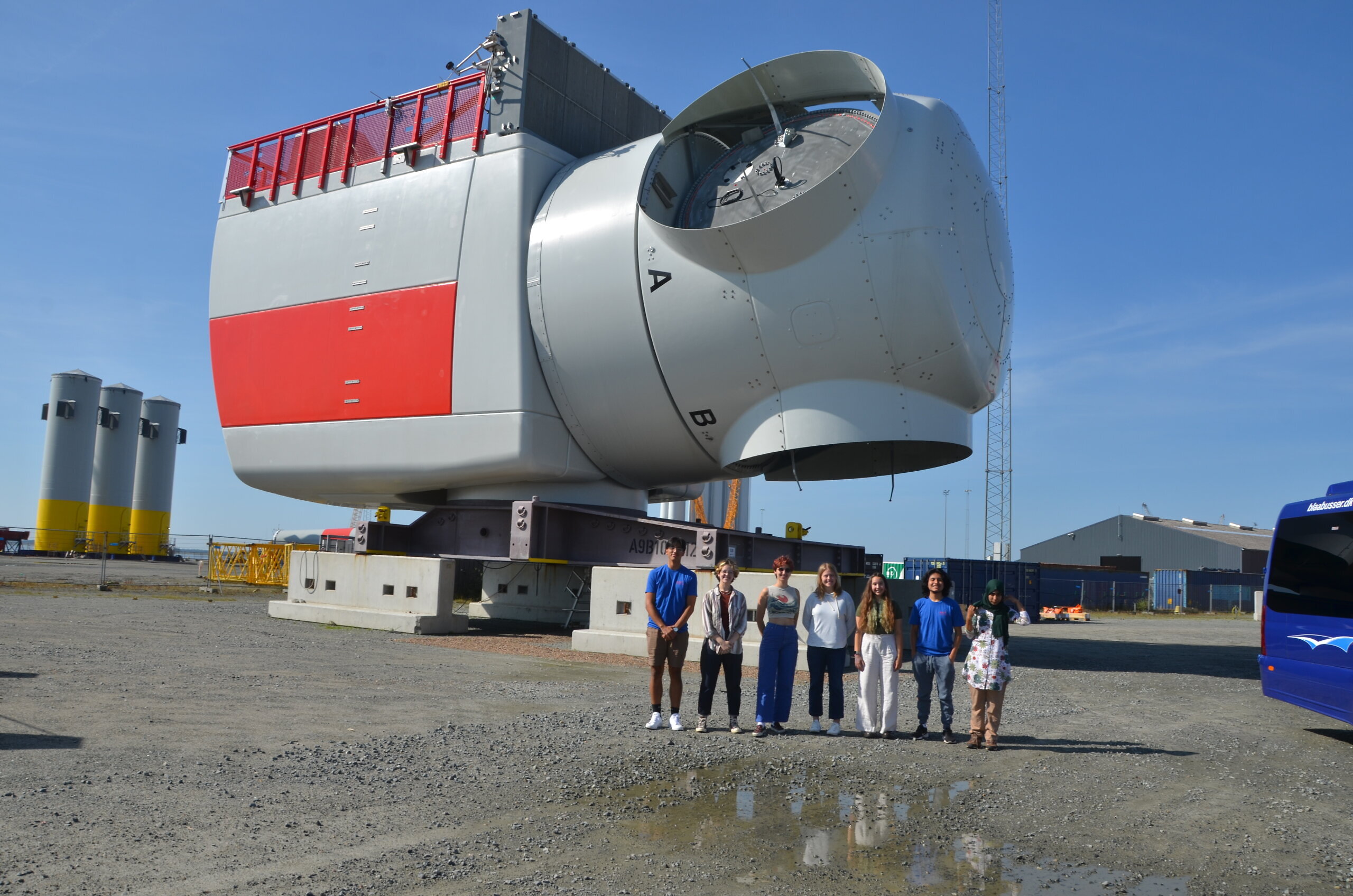
Six MIT students got a first-hand view of the energy industry in Denmark as part of a field trip in August 2024. With support from the MIT Energy Initiative, they visited startups working on safer nuclear energy production; local utility companies integrating offshore wind, biowaste, and district heating; a green-energy-based business park; and more.
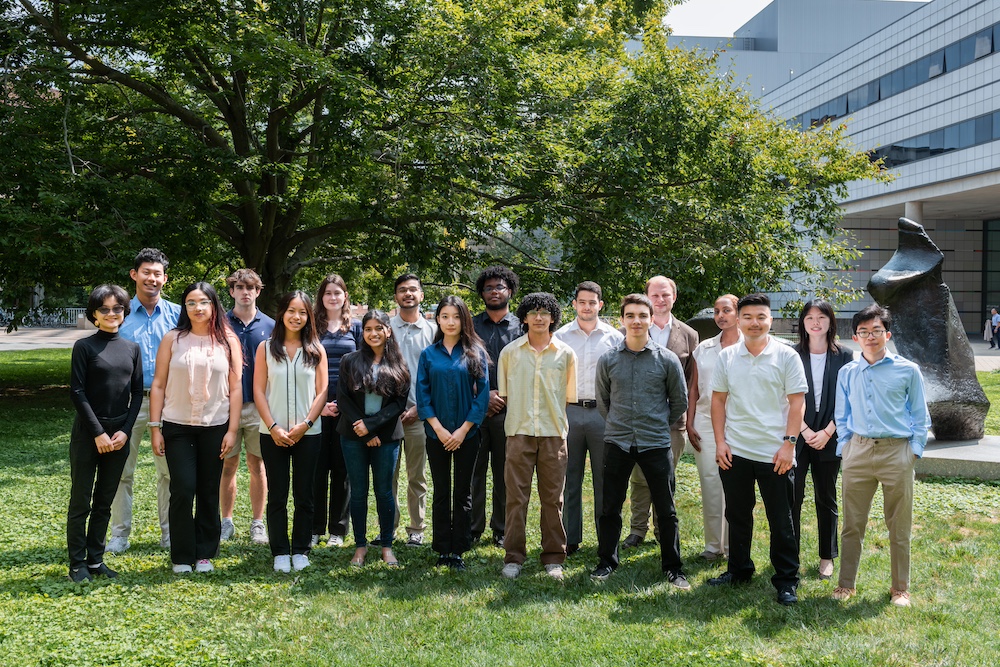
Summer-UROP-Group-Shot.jpg: During summer 2024, 24 students conducted energy research through MITEI’s Energy Undergraduate Research Opportunities Program. Photo: A. Laiman – MIT Technique

At MITEI’s 2024 Annual Research Conference, Energy UROP students presented their research to MITEI’s corporate members and conference attendees during poster sessions. Photo: Jake Belcher
MITEI Education Program Highlights
- Energy Studies Minor: MITEI supports and regularly updates the Energy Studies Minor curriculum, relying on an endowed fund provided by a generous donor. The Energy Studies Minor enables undergraduate MIT students to gain an integrative understanding of energy and develop the skills required of tomorrow’s energy professionals, leaders, and innovators in research, industry, policy, management, and governance. 216 students have graduated with the Energy Studies Minor, including four that graduated in 2025. Eight are on track to graduate with the minor in 2026. The new Chair of the Energy Minor Oversight Committee, Professor Daniel Frey (Mechanical Engineering), worked with the committee to evaluate course development proposals that MITEI then funded to refresh the Energy Minor Curriculum. A particular goal is enhancing connections between the energy minor and computer science, including promising applications of AI/machine learning for analyzing and solving energy challenges. Increasingly, we are also coordinating with other energy/climate/sustainability offerings at MIT to enhance efficiency and to be complementary in the curriculum, to engage students, and to link with Climate Project initiatives as those take shape.
- Teaching Assistant support: MITEI provided support for graduate teaching assistants in the following subjects: 1.067[J]: Energy Systems for Climate Change Mitigation, 5.812[J]: Principles of Innovation, EC.711: Introduction to Energy in Global Development, and EC.712[J]: Applications of Energy in GlobalD MITEI also provided course development funds for 8.01x: Information and Entropy: Energy and Exergy.
- Postgraduate Scholars: In 2024–2025, MITEI welcomed 14 new graduate students and postdocs to the Society of Energy Scholars (formerly known as the Society of Energy Fellows). The Energy Scholars network at the end of FY25 totaled more than 540 current and former graduate students and postdoctoral fellows, spanning 20 departments and divisions at MIT’s five schools and one college. In FY25, support was provided by MITEI member companies Shell, Chevron, Eni S.p.A., and ExxonMobil, and by Friends of MITEI.
- Undergraduate energy research: During FY25, MITEI supported 85 Undergraduate Research Opportunities Program (UROP) student projects, bringing the total UROPs supported by MITEI since inception to 1,060.
- Online energy courses: To train global professionals, policy makers, and students in energy topics and tools to support and accelerate the energy transition, the MITEI education team has developed a series of open online courses (MOOCs) based on interdisciplinary residential MIT subjects. These courses are free and available in almost every country, and have attracted more than 145,000 online learners. The courses cover critical aspects of future energy systems: load and demand-side management; economics and regulation; production, distribution, and transmission; mobility; and integrating climate topics across disciplines. The courses include Sustainable Building Design; Sustainable Energy; Energy Economics and Policy; Transformative Living Labs in Mobility; and Climate in Classrooms: Tools for All Teachers and Disciplines.
- IAP courses: MITEI supported several IAP courses in January 2025. “Information and Entropy: Energy and Exergy” focused on the concept of entropy and its connection to information theory, as well as ideas about exergy and the usefulness of energy, energy efficiency, and CO2. “AI for Energy Solutions” (47-210 attendees, depending on the lecture), which explored the applications of AI/machine learning to climate and energy challenges, and was offered to MIT and participants out of MIT via Zoom. “Computational Modeling for Clean, Reliable, and Affordable Electricity” offered a hands-on learning experience introducing analysis techniques to model and understand the role of electric power systems within a carbon-constrained economy, for which 49 students enrolled.
- First-Year Pre-Orientation Program (FPOP): MITEI’s summer 2024 energy pre-orientation program welcomed 18 new first-year students to the MIT community. Activities included a visit to a sustainable farm, tours of MIT’s Nuclear Reactor Lab and the Plasma Science and Fusion Center, and talks with faculty and student group leaders.
- Field trip to Europe: In August 2024, MITEI Education Director Antje Danielson took six undergraduate and graduate students to Denmark to explore renewable energy startups and visit the Danish Tech University in Copenhagen.
- Support for student groups: MITEI provides financial and staff support for a number of student groups throughout the year. In FY25, these included the MIT Energy and Climate Club, MIT Solar Vehicle Team, MIT Motorsports, MIT Wind, the MIT Sustainable Engine Group, the MIT TPP Policy Hackathon, and the MIT Energy and Climate Hackathon.
Outreach

At MITEI’s 2024 Annual Research Conference, Energy UROP students presented their research to MITEI’s corporate members and conference attendees during poster sessions. Photo: Jake Belcher
Priority update: Engage more broadly with MIT campus
A major priority for MITEI in FY25 was to strengthen MITEI’s connection across campus and ensure a better understanding of MITEI’s mission. MITEI did this by launching a new podcast, What if it works?, and speaker series, MITEI Presents: Advancing the Energy Transition, in fall 2024. MITEI also increased its collaborations with other departments, labs, and centers (DLCs) and campus groups. On campus and beyond, MITEI’s outreach efforts foster dialogue within the research community and across the academic, industry, and government sectors and provide the public with context on current energy issues. In FY25, the MITEI communications team published 25 original news articles, including event coverage, research reports, and explainers, to highlight MIT energy researchers and students, and their work across print and digital platforms. MITEI articles are frequently republished by MIT News, providing broader reach through MIT News’ channels. Additionally, MITEI worked with other DLCs to bring important industry and policy leaders to campus to engage with the MIT community. This included a partnership with MIT Ukraine, MIT Security Studies Program, and the Belfer Center at Harvard University to bring Volodymyr Kudrytskyi, the former CEO of Ukraine’s electric grid operator Ukrenergo, to discuss the challenges of securing Ukraine’s energy system throughout the war.

Left: At MITEI’s Earth Day Colloquium, Manish Bapna, the president and CEO of the Natural Resources Defense Council, advocated for reinstating climate action as a national priority. Photo: Kelley Travers. Right: Lucia Tian (center), the head of clean energy and decarbonization technologies at Google, discusses the challenges and opportunities that AI and rapid electrification bring to electricity demand during a panel at the 2025 MIT Energy Conference. Photo: Rory Fisher
Outreach Program Highlights
- MITEI Presents: Advancing the Energy Transition speaker series: Launched in September 2024, this speaker series connects the MIT community with energy experts and leaders who are actively working on the scientific, technological, and policy solutions we urgently need to transform our energy systems. Six speakers were brought to campus this FY, including Alicia Barton, CEO of Vineyard Offshore; U.S. Representative Sean Casten of Illinois; Joseph F. DeCarolis, administrator of the U.S. Energy Information Administration; Emily Knight, president and CEO of The Engine; Manish Bapna, president and CEO of the Natural Resources Defense Council (more below); and Emily A. Carter, the Gerhard R. Andlinger Professor in Energy and the Environment at Princeton University.
- Podcast: What if it works? : In October 2024, MITEI launched its podcast series, What if it works? Season one gained more than 1,000 subscribers with 18 published episodes by the end of FY25. Every two weeks, MITEI hosts Rob Stoner, MITEI’s former deputy and interim director, and Kara Miller spoke with energy experts about the science, technology, and policies that can transform our energy systems and give us a more sustainable future. Guests included Ernest Moniz, former U.S. Secretary of Energy, MIT professor emeritus, and MITEI founder; Susan Solomon (Earth, Atmospheric and Planetary Sciences); Climate Project Mission Directors Elsa Olivetti (Material Science and Engineering) and Christopher Knittel (MIT Sloan); Howard Herzog (MITEI); and Namrata Kala (MIT Sloan).
- The Energy of the Future video series: In March 2025, MITEI launched a video series on social media showcasing the work of MITEI’s energy students and their efforts to advance the energy transition and expand energy access. This series supports MITEI’s priority of engaging more broadly with campus and growing its social media audiences. In FY25, MITEI published five videos featuring Energy UROP participants on Instagram and LinkedIn. MITEI promoted the videos across campus with both print and digital advertisements and a special display in the Infinite Corridor.
- Spring Symposium: In May 2025, MITEI advanced its focus on data centers at our Spring Symposium, which brought together researchers, industry leaders, and academic experts to explore artificial intelligence as both a problem and solution for the clean energy transition. Speakers included Vijay Gadepally, a senior scientist at MIT’s Lincoln Lab; Evelyn Wang, MIT Vice President for Energy and Climate; Antonia Gawel, global director of sustainability and partnerships at Google; and Dustin Demetriou, senior technical staff member in sustainability and data center innovation at IBM.
- Earth Day Colloquium: As part of MIT’s celebration of Earth Week, MITEI hosted Manish Bapna, the president and CEO of the Natural Resources Defense Council, one of the United States’ largest environmental organizations, who advocated for reinstating climate action as a national priority.
- Congressional Staff Seminar 2025: MITEI, the MIT Washington Office, and the Climate Policy Center jointly hosted a bipartisan group of 27 U.S. House, Senate, and Congressional committee staffers for three days of panels, tours, and presentations from faculty, research scientists, and students about energy and climate research. Topics included climate & AI, the role of nuclear energy in U.S. power generation, and electricity transmission, among others.
- Annual Research Conference 2024: Energy researchers, policy makers, and industry members came together this year to explore the topic of “A durable energy transition: How to stay on track in the face of increasing demand and unpredictable obstacles.” The conference included eight panels that featured MIT moderators, 13 MIT panelists, and 19 panelists from other academic institutions, government, or industry. MIT President Sally Kornbluth opened the conference, and the keynote speaker was Praveer Singh, CEO and Managing Director of the Tata Power Co, Ltd. In collaboration with MIT’s Industrial Liaison Program, the conference also highlighted seven companies with a Startup Showcase session. MITEI’s summer UROP students participated in a slam, presenting their research to MITEI’s corporate members and conference attendees.
- C3E 2024 Women in Clean Energy Symposium: In November 2024, the 13th annual Clean Energy, Education, and Empowerment (C3E) Women in Clean Energy Symposium and Awards was hosted by Stanford Energy in collaboration with MITEI, the U.S. Department of Energy, and Julie Ann Wrigley Global Futures Laboratory at Arizona State University. The conference featured award presentations, as well as diverse speakers and rich conversations on pursuing sustainable clean energy goals. The U.S. C3E Initiative advances clean energy by closing the gender gap and increasing the participation, leadership, and success of women in clean energy fields.
MITEI news from FY25
MIT reports of MITEI impact
Decarbonizing steel is as tough as steel
Study helps pinpoint areas where microplastics will accumulate
A new approach could fractionate crude oil using much less energy
MIT students advance solutions for water and food with the help of J-WAFS
Technology developed by MIT engineers makes pesticides stick to plant leaves
Will neutrons compromise the operation of superconducting magnets in a fusion plant?
Rooftop panels, EV chargers, and smart thermostats could chip in to boost power grid resilience
Smart carbon dioxide removal yields economic and environmental benefits
A platform to expedite clean energy projects
Toward sustainable decarbonization of aviation in Latin America
MIT engineers make converting CO2 into useful products more practical
Preparing Taiwan for a decarbonized economy
The changing geography of “energy poverty”
MIT spinout Arnasi begins applying LiquiGlide no-stick technology to help patients
Startup helps farmers grow plant-based feed and fertilizer using wastewater
Roosevelt Project unveils policy report on iron and steel decarbonization
MITEI Members
MITEI’s corporate member program facilitates collaborations between industry and MIT to research, develop, and accelerate low- and zero-carbon solutions for the energy transition. MITEI’s member roster is reflective of MITEI’s mission to work across the broad industrial spectrum of energy production, conversion, delivery, and usage.
Member Highlights
- Overall, in FY25, MITEI maintained a steady membership roster of 38 members. Reflecting ongoing efforts to diversify across the energy spectrum, MITEI welcomed several notable new members, including Copenhagen Infrastructure Partners, Siemens Energy, and RWE (a German multinational energy company). MITEI also welcomed GE Vernova as part of their role in the new MIT-GE Vernova Research Alliance. GE Vernova’s Sustaining membership in MITEI was finalized in early FY26.
- A key focus in FY25 was the successful renewal of Founding and Sustaining memberships and memberships within the Future Energy Systems Center.
- As members’ research organizations rebounded from Covid-19 disruptions, their research priorities evolved from single-PI, relatively straightforward projects to complex, multi-disciplinary initiatives involving multiple PIs. To support this shift, MITEI organized workshops that connected members and PI teams, enabling them to pitch project ideas to founding members ExxonMobil and Shell. As a result, we have launched—or are on the verge of launching—six complex, multi-PI, multi-year projects aimed at addressing critical challenges across all aspects of the energy transition.
- As part of MITEI’s efforts to help industry and governments facing critical energy transition decisions, MITEI executed a workshop in Taiwan under the TIGER Consortium. This was a collaboration with the EPOCH Foundation meant to help Taiwan develop a robust roadmap for its own green energy transition.
Along with financial support for research, analyses, and education, industry members contribute valuable perspectives and detailed knowledge of real-world conditions for practical scaling-up, deployment, and integration of decarbonization solutions.
MITEI draws on MIT’s research capabilities, innovation, expertise, and experience to create successful industry collaborations to meet its research partners’ key strategic objectives. A multi-tiered membership structure enables diverse private-sector partners to sponsor multidisciplinary “flagship” research programs with MIT faculty; contribute to energy-focused labs, programs, and centers at MIT; fund undergraduate and graduate students working on the energy transition; support innovative energy concepts from proposals solicited across the campus; and participate in MITEI’s seminars, lectures, and colloquia.
A list of members is available on the MITEI website.
Affiliated Groups
MITEI collaborates on research and education activities with faculty members from many MIT centers, departments, and laboratories pursuing interdisciplinary energy and environmental activities. In particular, researchers from both the Center for Energy and Environmental Policy Research (CEEPR) and the Center for Sustainability Science and Strategy (CS3) are working with MITEI researchers to support the work of the Future Energy Systems Center.
Center for Energy and Environmental Policy Research
CEEPR promotes research on energy and environmental policy to support improved decision-making by government and industry. It is directed by Associate Dean for Climate and Sustainability and the George P. Schultz Professor of Applied Economics Christopher Knittel (MIT Sloan), and jointly sponsored by MITEI, the Department of Economics, and the MIT Sloan School of Management.
CEEPR carries out rigorous and objective research for improved decision-making in government and the private sector, and closely cooperates with government and industry partners from around the globe. Affiliated faculty and research staff as well as external research affiliates contribute to the empirical study of a wide range of policy issues related to energy supply and demand and the environment. CEEPR produces working papers, policy briefs, and research input to larger, interdisciplinary studies, and hosts two annual research workshops at MIT. CEEPR has extensive previous and current international collaborations and has co-organized a series of international energy policy conferences.
CEEPR houses the Roosevelt Project, a research initiative that takes a multidisciplinary approach to examining the transitional challenges associated with deep decarbonization of the U.S. economy. The project was initiated by former U.S. Secretary of Energy and Cecil and Ida Green Professor of Physics and Engineering Systems emeritus Ernest J. Moniz and engages a breadth of MIT and Harvard faculty and researchers across academic domains including economics, engineering, sociology, urban studies and planning, and political science.
Center for Sustainability Science and Strategy
In August 2024, the MIT School of Science launched a center to advance knowledge and computational capabilities in the field of sustainability science, and support decision-makers in government, industry, and civil society to achieve sustainability goals. Aligned with the Climate Project at MIT, researchers at the MIT Center for Sustainability Science and Strategy (CS3) develop and apply expertise from across the Institute to improve understanding of sustainability challenges, and thereby provide actionable knowledge and insight to inform strategies for improving human well-being for current and future generations. Noelle Selin, professor at MIT’s Institute for Data, Systems and Society and the Department of Earth, Atmospheric and Planetary Sciences, serves as the center’s inaugural faculty director. C. Adam Schlosser and Sergey Paltsev, a senior research scientist at MITEI, serve as deputy directors, with Anne Slinn as executive director. CS3 incorporates and succeeds both the Joint Program on the Science and Policy of Global Change and the Center for Global Change Science.

